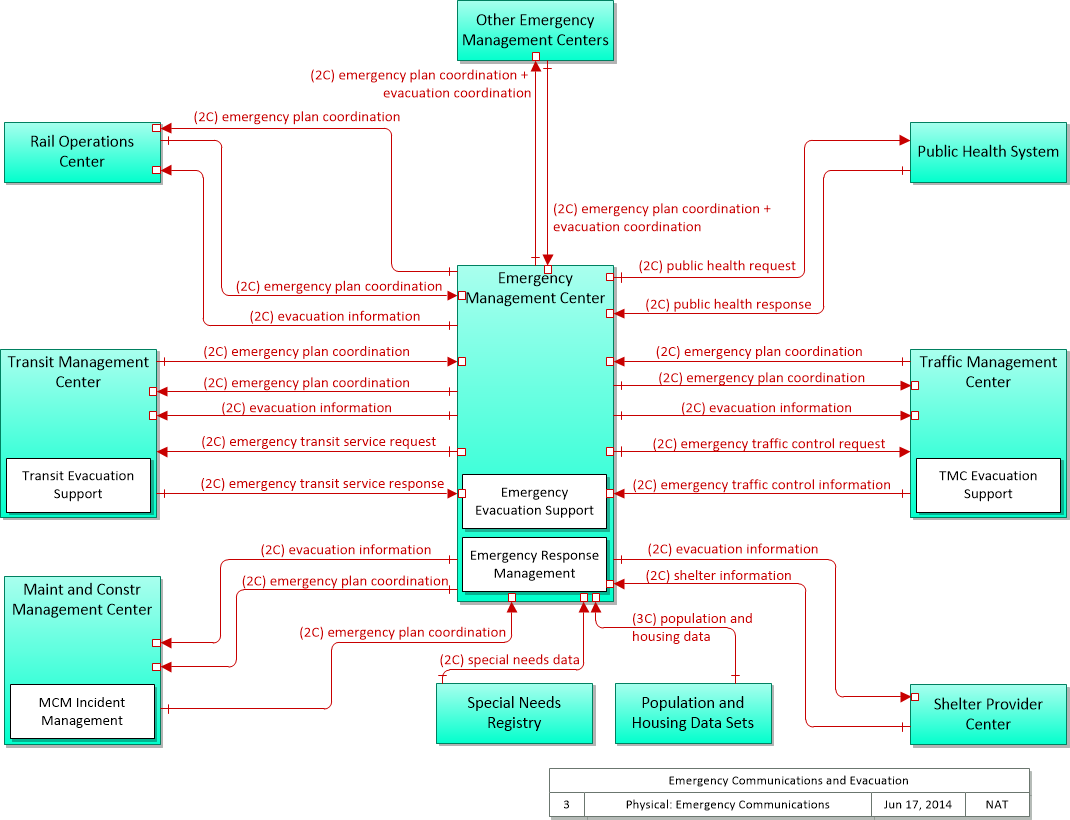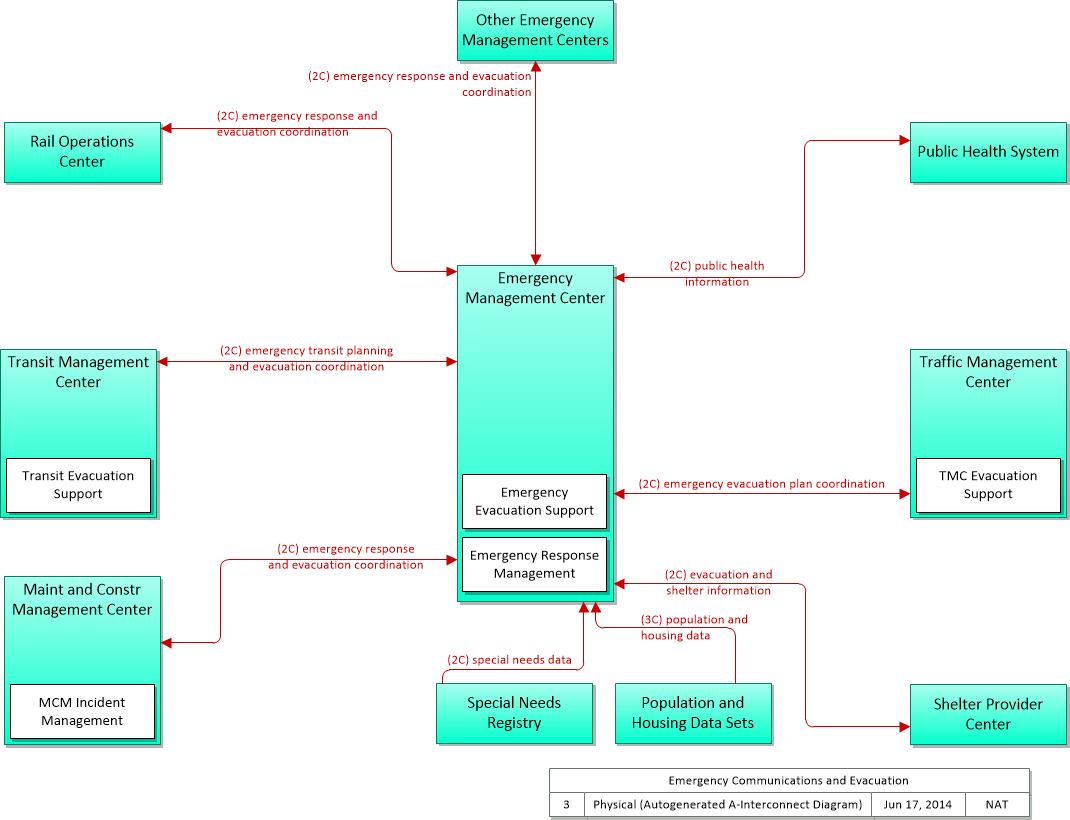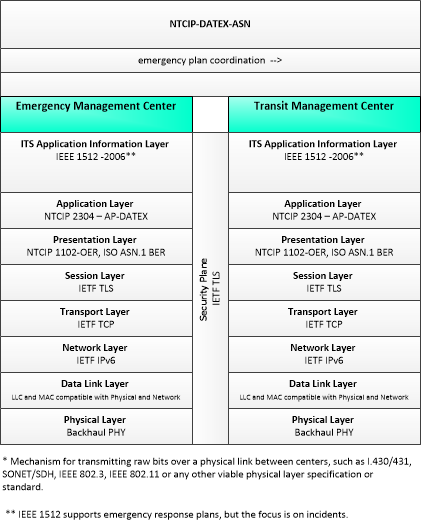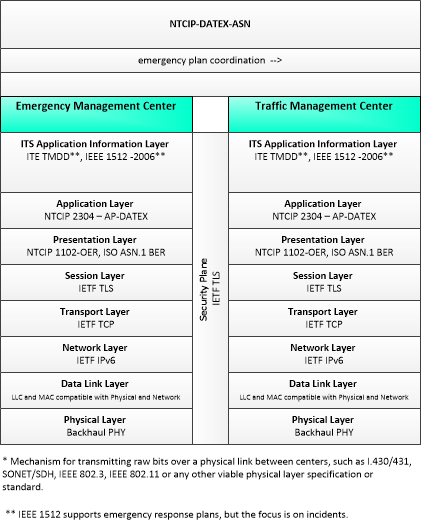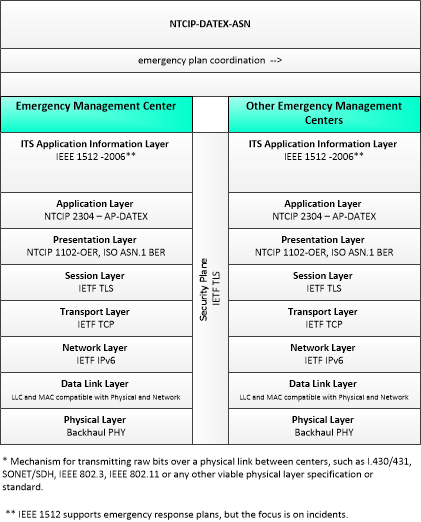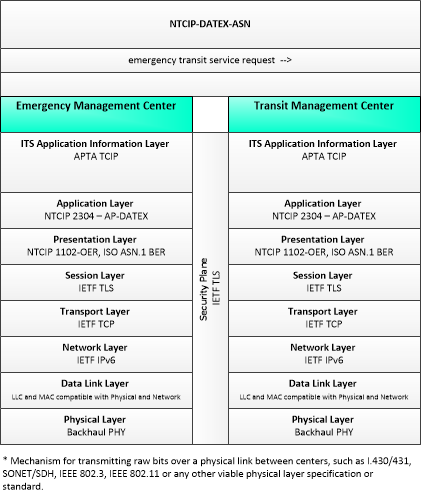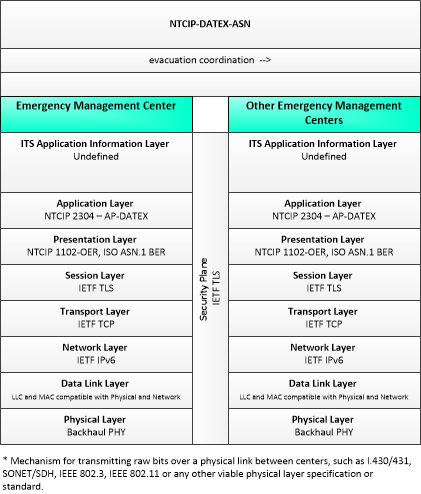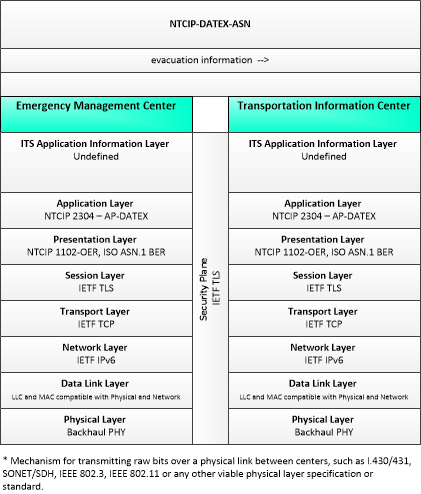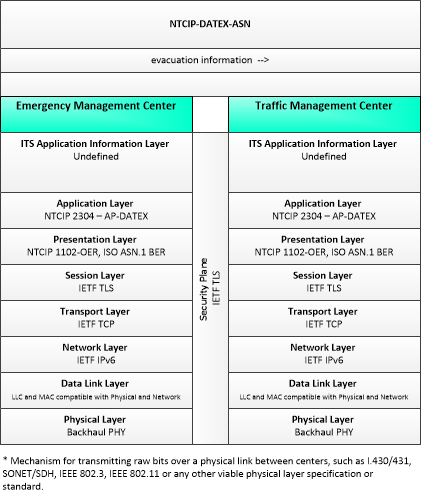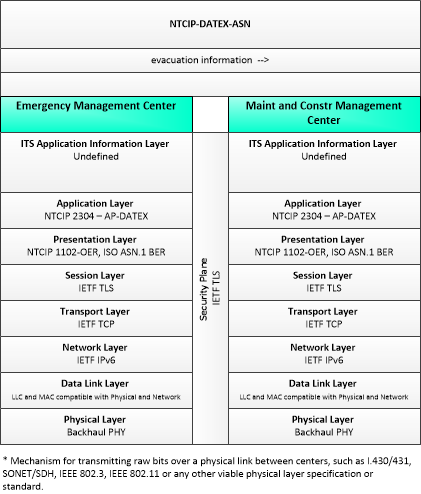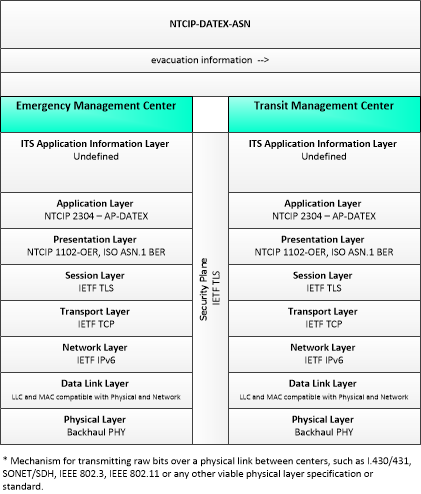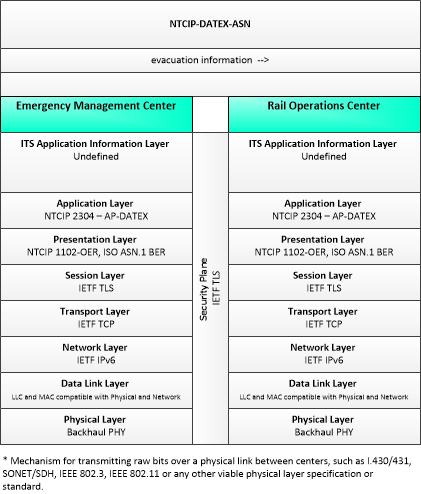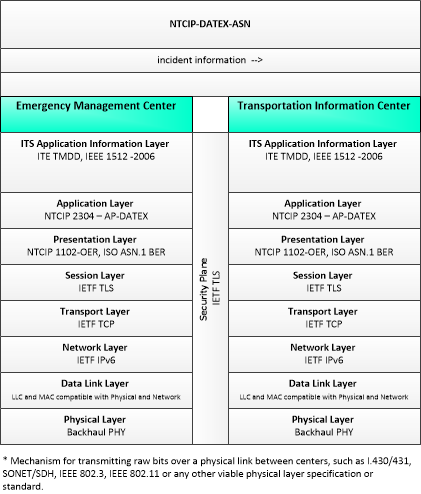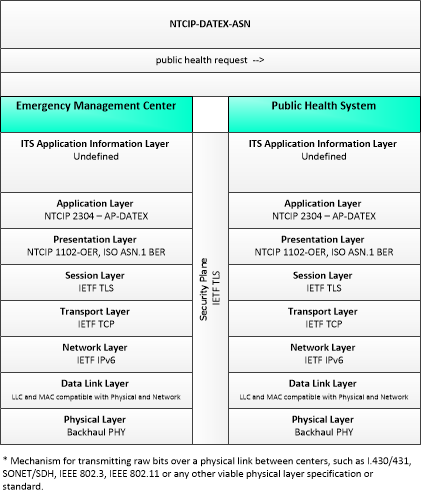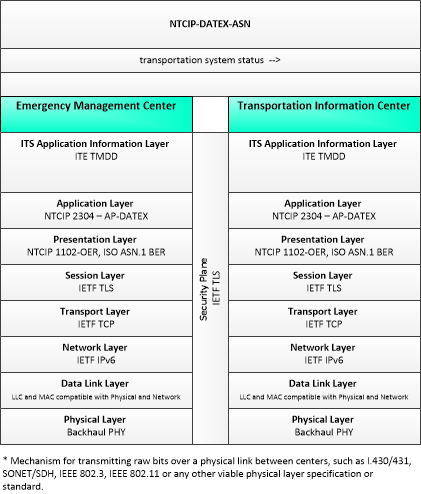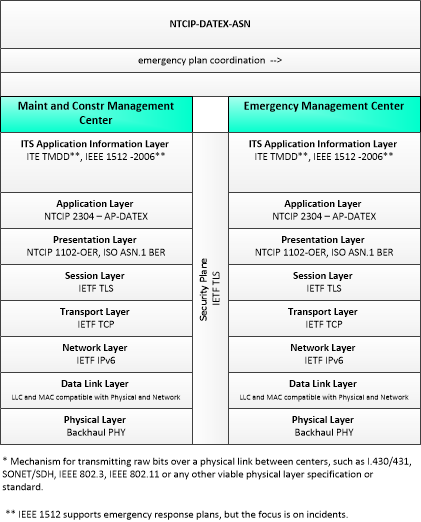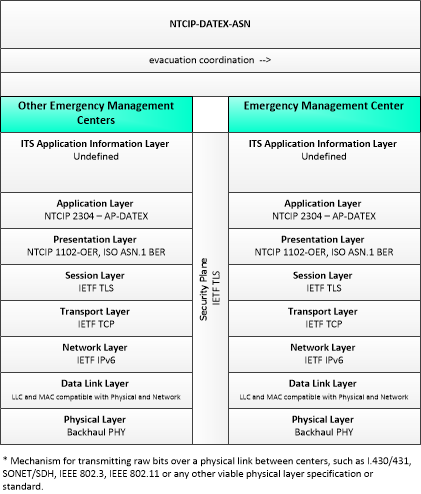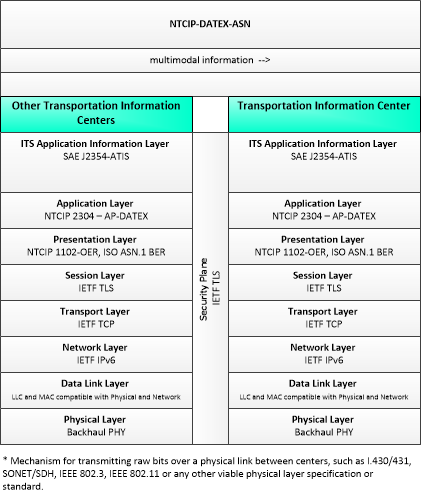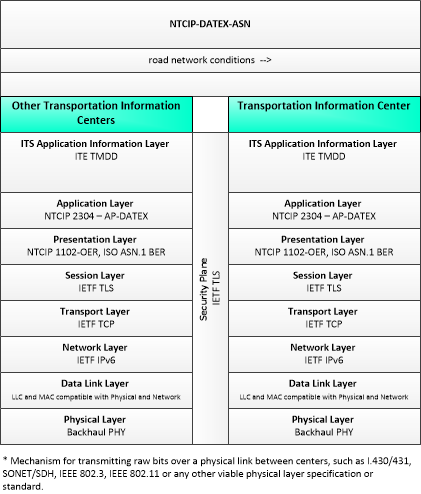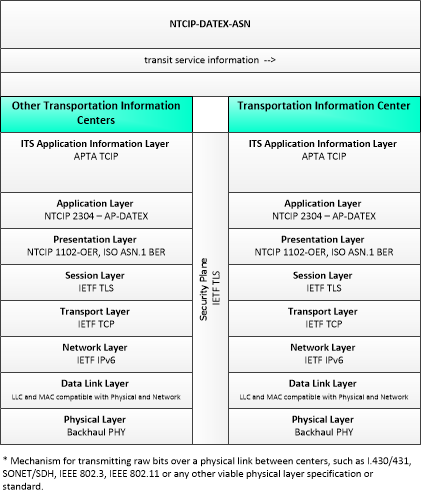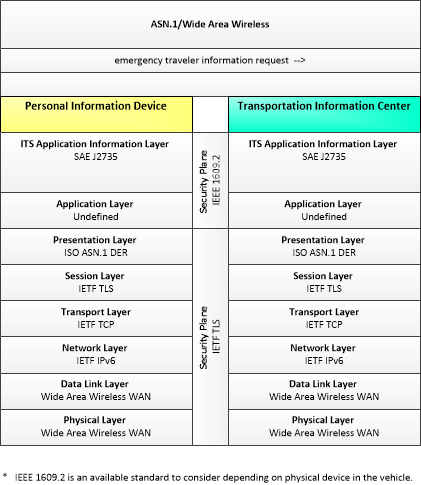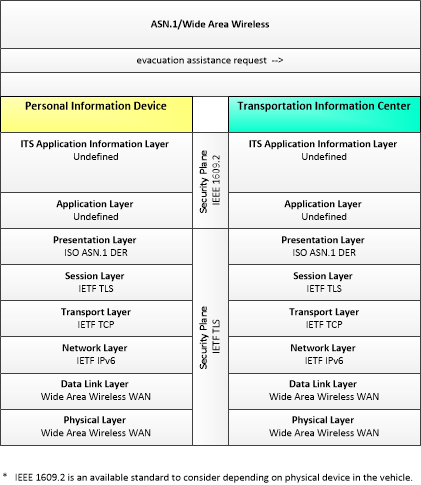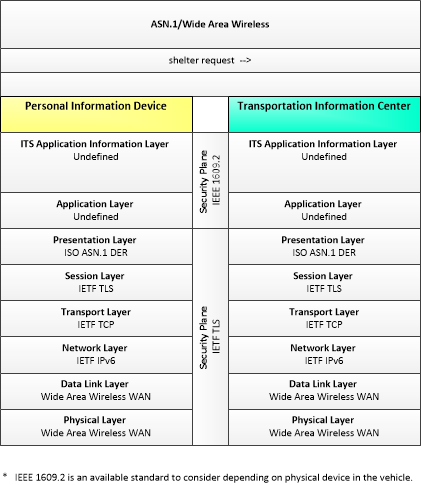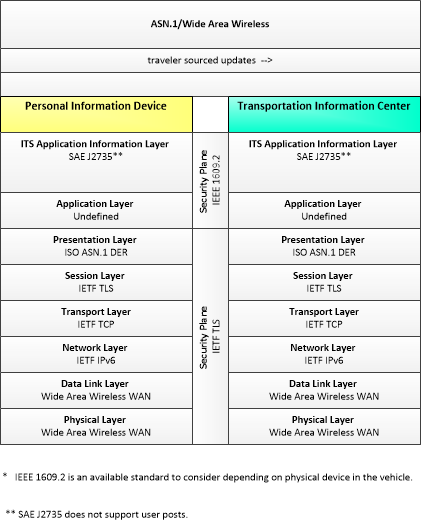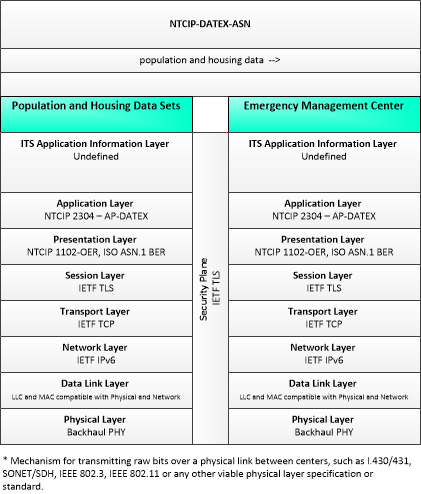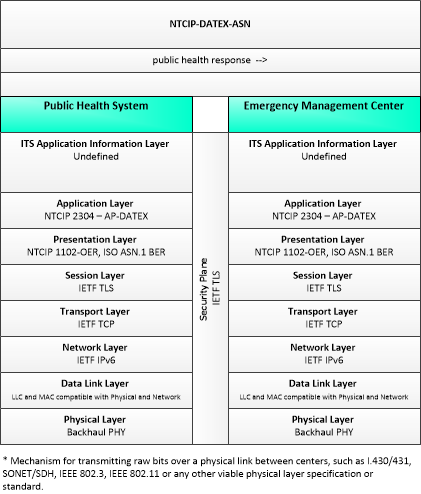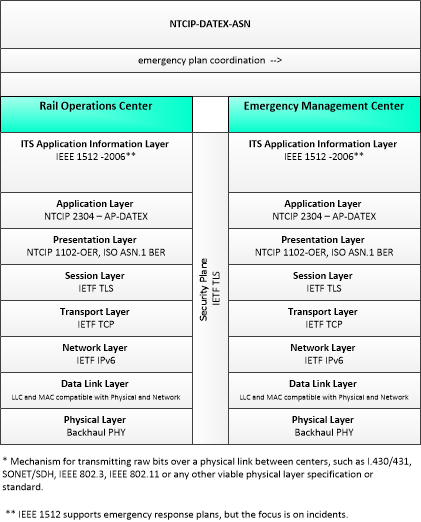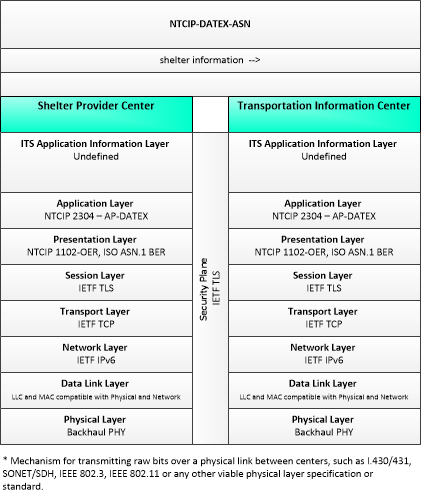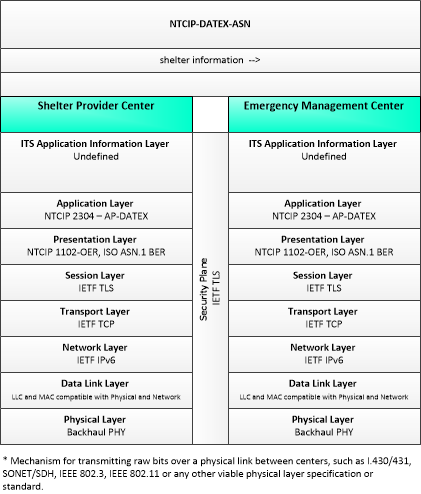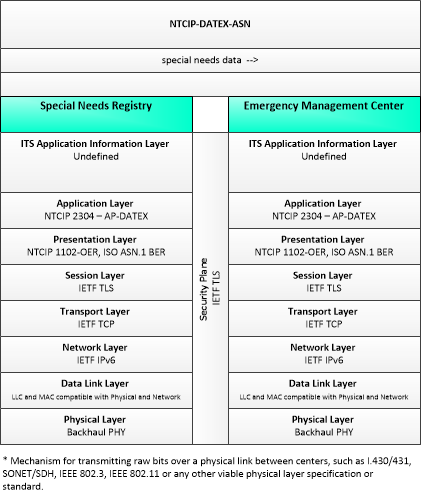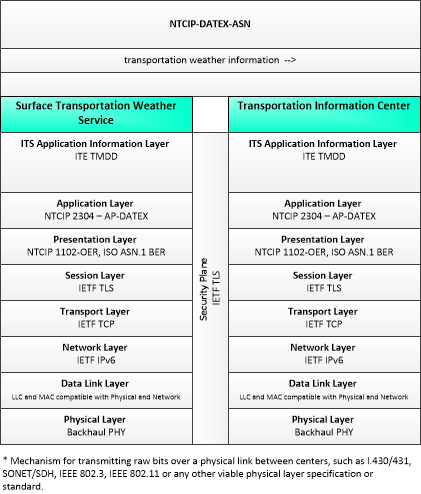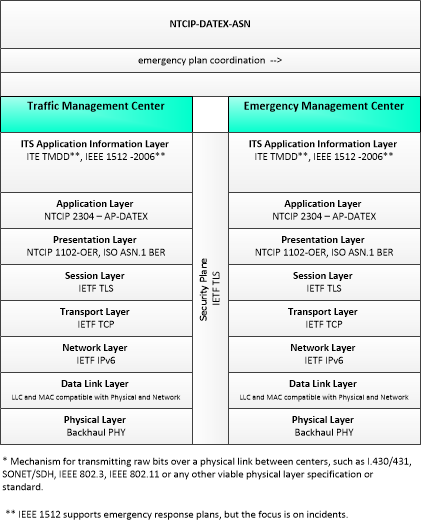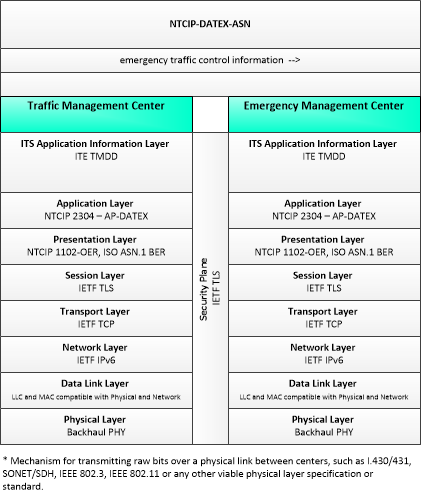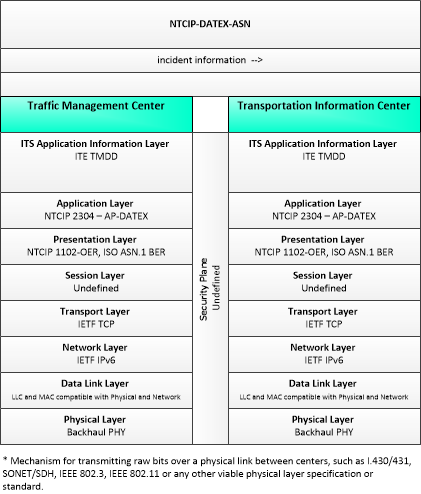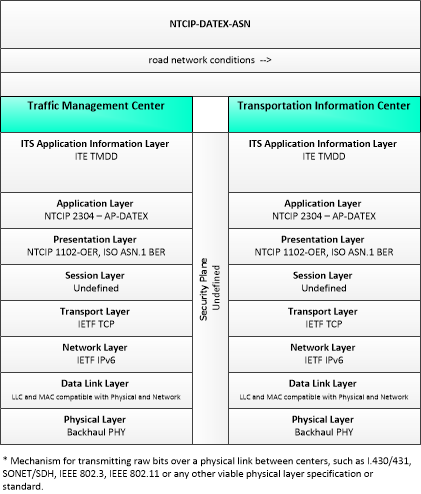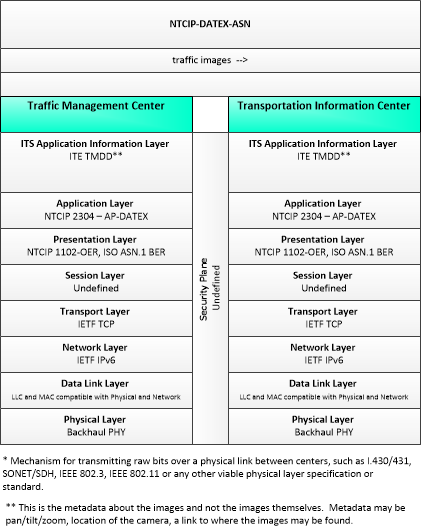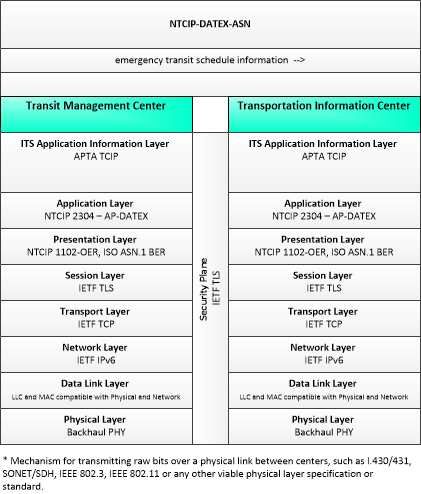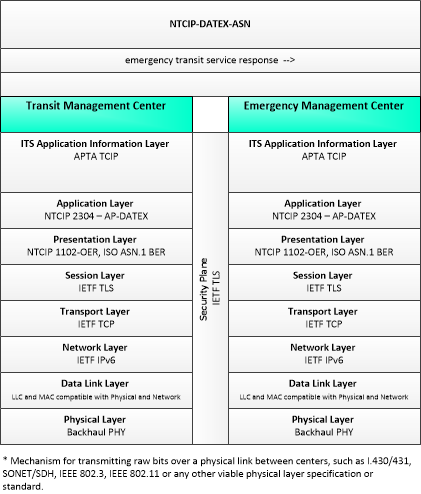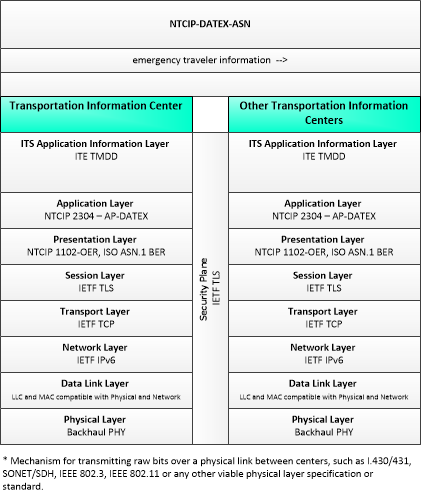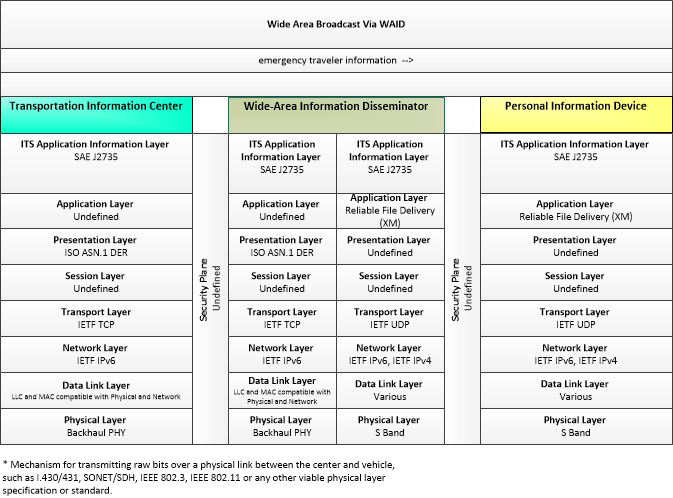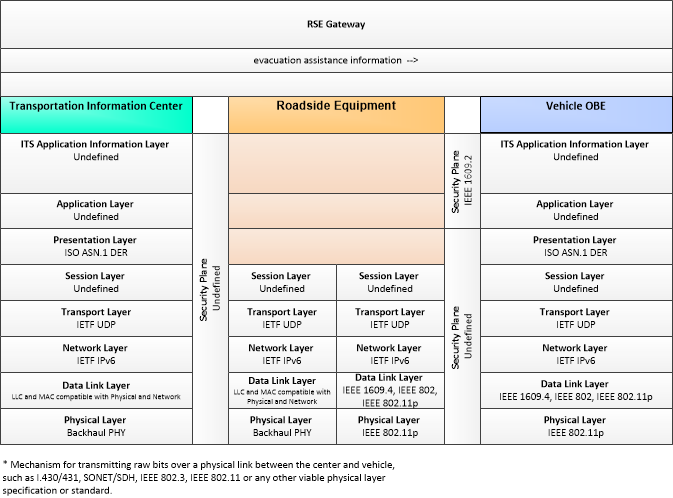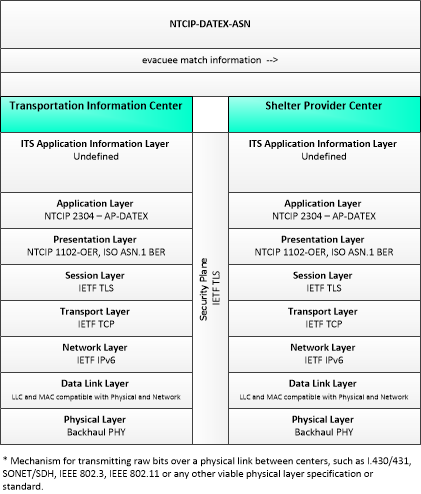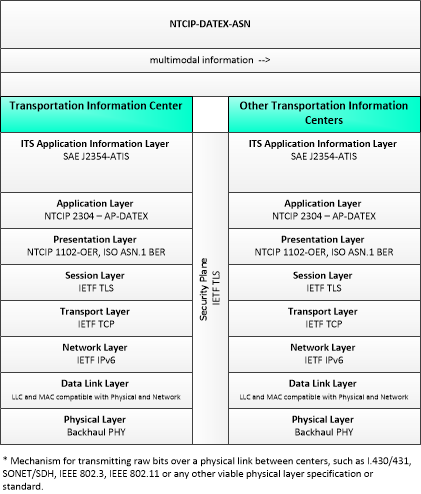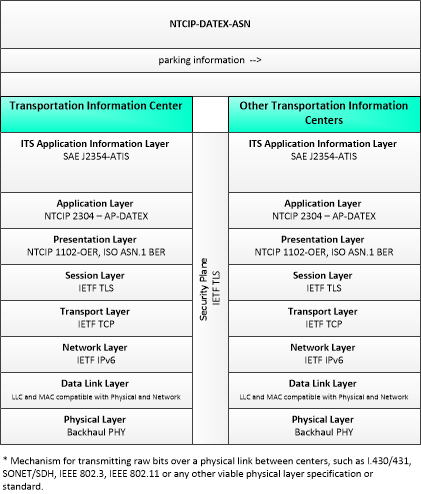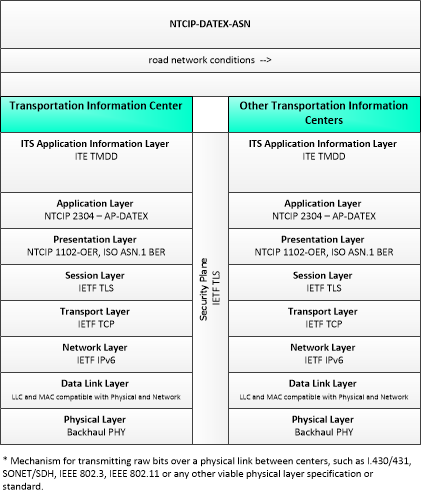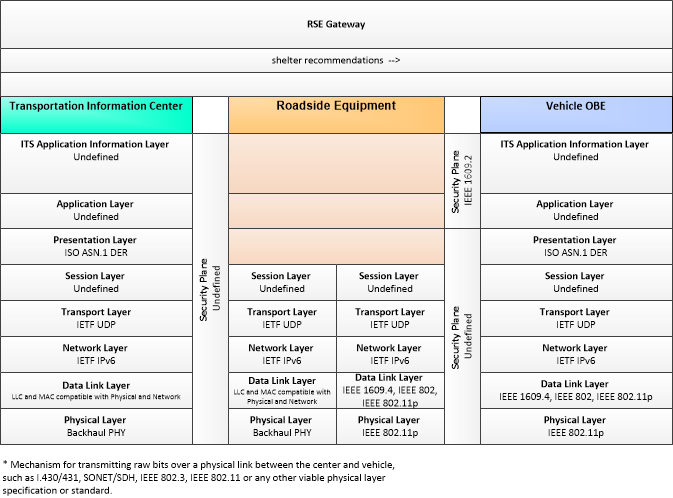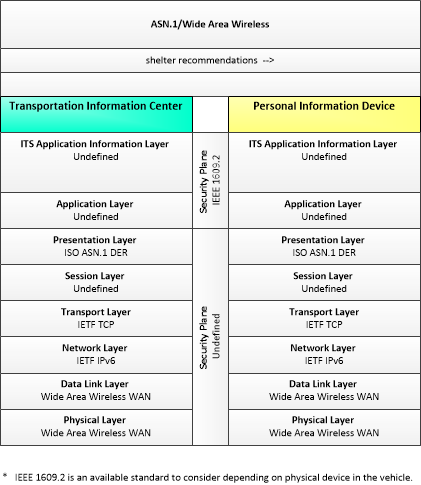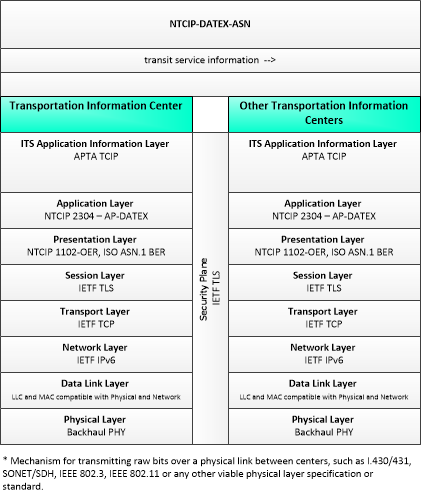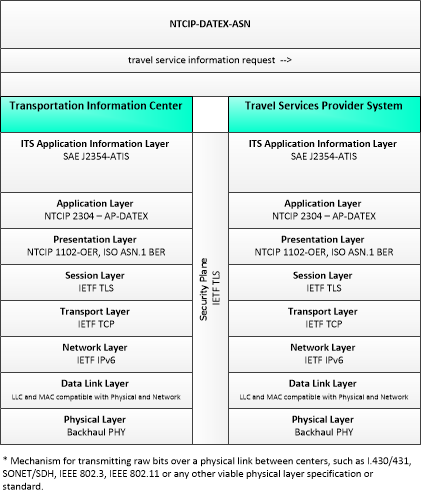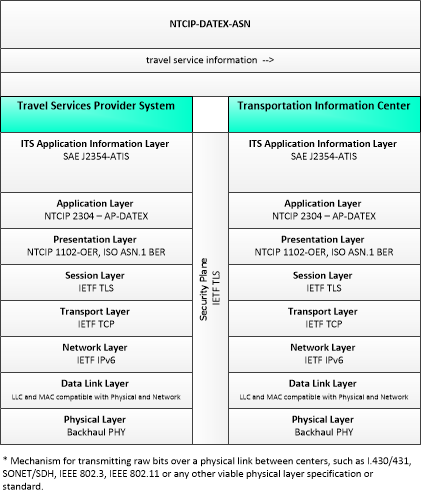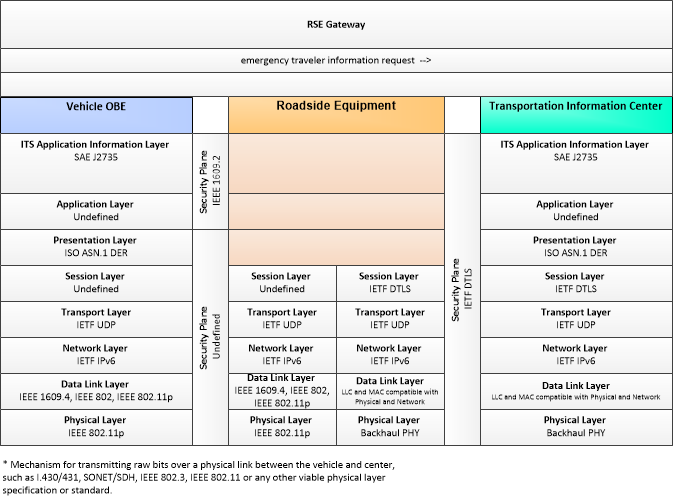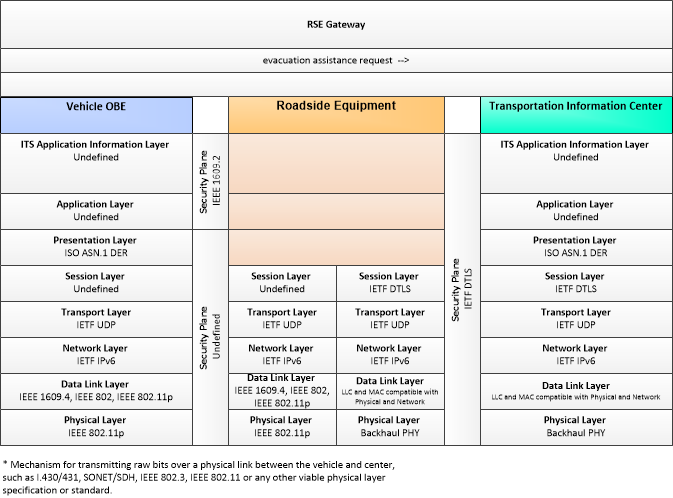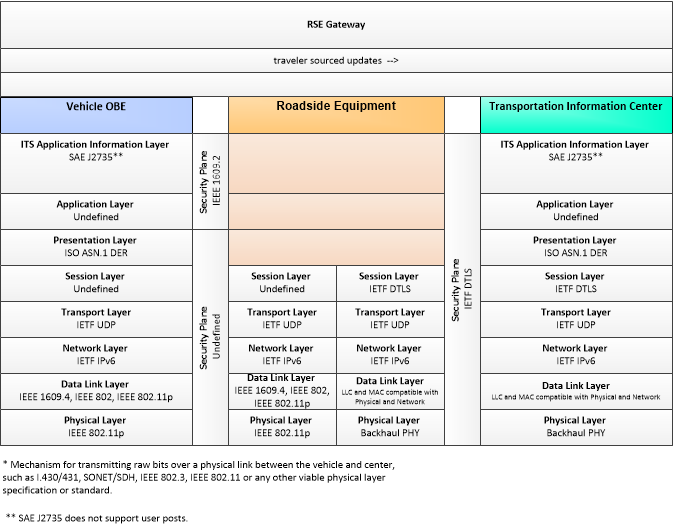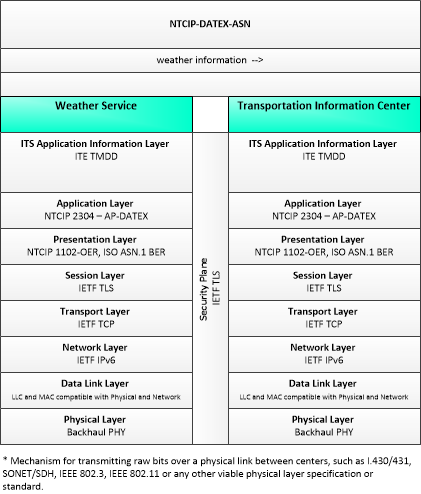Type: Mobility
Groups:- Public Safety
Emergency Communications and Evacuation
The Emergency Communications and Evacuation (EVAC) application contains multiple functions to support the efficient evacuation of special needs and non special needs evacuees within a jurisdiction as well as provide real-time communications of evacuation instructions and routing guidance that accounts for current road and traffic conditions. This application integrates many of the existing functions that relate to emergency communications and evacuation, such as mass warning and notification systems, computer-aided dispatch/ automated vehicle location (CAD/AVL), traffic information, and weather data. For the End Users of the application, the majority of the functions will be accessed through a website and/or a Smartphone application or family of applications. During an incident, emergency management agencies would have the ability to push information such as evacuation orders by evacuation zone to registered users of the system. The TMC working with the Emergency Operations Center (EOC) will use the EVAC application to coordinate the listing of available transportation resources to assist with special needs evacuation. The EVAC application will dispatch and route the transportation resources to the appropriate location, while providing communications update to those special needs individuals in need of assistance. For non-special needs evacuees, the EVAC application will provide evacuation route guidance that accounts for road conditions, traffic conditions, and final destination. If the evacuee intends to go to a shelter or hotel, the EVAC application will provide a shelter matching function to help the evacuee determine where he or she should go based upon shelter availability and capability. Should the evacuee need a resource such as food or fuel along the evacuation route, the EVAC application can provide recommended stops and will incorporate user input feedback to provide information on the availability of the needed resource. Additionally, the EVAC application will provide a Return of Evacuees Function to provide evacuees with information regarding when they can return to their area of the jurisdiction and provide recommended routes taking into consideration road conditions (i.e., roadway infrastructure and traffic lights).
Enterprise
SVG Diagrams: Installation Operations Maintenance Certification
PNG Diagrams: Installation Operations Maintenance Certification

Business Interaction Matrix:
| Emergency Communications and Evacuation Operations Stage | |||||||||||||||||||||
|---|---|---|---|---|---|---|---|---|---|---|---|---|---|---|---|---|---|---|---|---|---|
| Vehicle Owner | Driver | Vehicle OBE Owner | Traffic Manager | Information Service Provider | Surface Transportation Weather Service System Operator | Weather Service Operator | Maint and Constr Manager | Rail Operator | Traveler | Emergency Manager | Other Emergency Manager | Travel Services Provider | Shelter Provider | Special Needs Registry Manager | Public Health System Manager | Population and Housing Data Manager | Transit Fleet Manager | Other Information Service Provider | Vehicle Interactive Traveler Information Provider | Personal Interactive Traveler Information Provider | |
| Vehicle Owner | Vehicle Usage Agreement | Vehicle OBE Usage Agreement | Application Usage Agreement | ||||||||||||||||||
| Driver | Vehicle Usage Agreement | Expectation of Information Provision | |||||||||||||||||||
| Vehicle OBE Owner | Vehicle OBE Usage Agreement | Expectation of Information Provision | Information Exchange Agreement | ||||||||||||||||||
| Traffic Manager | Information Exchange Agreement | Information Exchange Agreement | |||||||||||||||||||
| Information Service Provider | Information Exchange Agreement | Information Exchange Agreement | Information Exchange Agreement | Information Exchange Agreement | Expectation of Data Provision | Information Exchange Agreement | Information Exchange Agreement | Information Exchange Agreement | Information Exchange Agreement | Information Exchange Agreement | |||||||||||
| Surface Transportation Weather Service System Operator | Information Exchange Agreement | ||||||||||||||||||||
| Weather Service Operator | Information Exchange Agreement | ||||||||||||||||||||
| Maint and Constr Manager | Information Exchange Agreement | ||||||||||||||||||||
| Rail Operator | Information Exchange Agreement | ||||||||||||||||||||
| Traveler | Expectation of Data Provision | Application Usage Agreement | |||||||||||||||||||
| Emergency Manager | Information Exchange Agreement | Information Exchange Agreement | Information Exchange Agreement | Information Exchange Agreement | Information Exchange Agreement | Information Exchange Agreement | Information Exchange Agreement | Information Exchange Agreement | Information Exchange Agreement | Information Exchange Agreement | |||||||||||
| Other Emergency Manager | Information Exchange Agreement | ||||||||||||||||||||
| Travel Services Provider | Information Exchange Agreement | ||||||||||||||||||||
| Shelter Provider | Information Exchange Agreement | Information Exchange Agreement | |||||||||||||||||||
| Special Needs Registry Manager | Information Exchange Agreement | ||||||||||||||||||||
| Public Health System Manager | Information Exchange Agreement | ||||||||||||||||||||
| Population and Housing Data Manager | Information Exchange Agreement | ||||||||||||||||||||
| Transit Fleet Manager | Information Exchange Agreement | Information Exchange Agreement | |||||||||||||||||||
| Other Information Service Provider | Information Exchange Agreement | ||||||||||||||||||||
| Vehicle Interactive Traveler Information Provider | Application Usage Agreement | ||||||||||||||||||||
| Personal Interactive Traveler Information Provider | Application Usage Agreement | ||||||||||||||||||||
Includes Enterprise Objects:
| Enterprise Object | Description |
|---|---|
| Application Certification Entity | The body that determines whether an application may be deployed and operated in the Connected Vehicle Environment. This entity's composition, the requirements it applies and the procedures it uses to verify those requirements may vary with application type. For example, applications with human safety component (crash avoidance, movement assistance etc.) may have stringent requirements and extensive testing in a variety of conditions, while applications that provide strictly mobility functionality may have far less testing requirements; possibly as little as just making sure the application doesn't interfere with any other applications. |
| Device Certification Entity | The body that determines whether a device may be deployed and operated in the Connected Vehicle Environment. This entity's composition, the requirements it applies and the procedures it uses to verify those requirements may vary with device type. |
| Driver | The 'Driver' represents the person that operates a vehicle on the roadway. Included are operators of private, transit, commercial, and emergency vehicles where the interactions are not particular to the type of vehicle (e.g., interactions supporting vehicle safety applications). The Driver originates driver requests and receives driver information that reflects the interactions which might be useful to all drivers, regardless of vehicle classification. Information and interactions which are unique to drivers of a specific vehicle type (e.g., fleet interactions with transit, commercial, or emergency vehicle drivers) are covered by separate objects. |
| Emergency Evacuation Support Installer | Application Component Installers are specified more by role than by function. Installers are responsible for the installation of the application component, which may require a support system, and may entail agreements and relationships between end users and application providers. |
| Emergency Evacuation Support Maintainer | Application Component Maintainers are specified more by role than by function. Maintainers are responsible for the maintenance (configuration changes, patches and updates, hardware repairs) of the application component, which may require a support system, and may entail agreements and relationships between end users and application providers. |
| Emergency Evacuation Support Provider | Application Component Providers are specified more by role than by function. Providers are responsible for the development of the application component, including initial creation, enhancement and bug fixes. Delivery of the application to the end user may require relationships with other entities (installers, maintainers) if the provider chooses not to fulfill those roles. |
| Emergency Manager | The "Emergency Manager" represents agencies charged with incident management, disaster response, and transportation environment security. |
| Emergency Response Management Installer | Application Component Installers are specified more by role than by function. Installers are responsible for the installation of the application component, which may require a support system, and may entail agreements and relationships between end users and application providers. |
| Emergency Response Management Maintainer | Application Component Maintainers are specified more by role than by function. Maintainers are responsible for the maintenance (configuration changes, patches and updates, hardware repairs) of the application component, which may require a support system, and may entail agreements and relationships between end users and application providers. |
| Emergency Response Management Provider | Application Component Providers are specified more by role than by function. Providers are responsible for the development of the application component, including initial creation, enhancement and bug fixes. Delivery of the application to the end user may require relationships with other entities (installers, maintainers) if the provider chooses not to fulfill those roles. |
| Federal Regulatory | Federal regulatory bodies that have legal authority to control and/or provide input to policies regulating transportation infrastructure and operations. This includes entities such as the Federal Communications Commission and US Department of Transportation. |
| Information Service Provider | The "Information Service Provider" represents the owner of the Transportation Information Center. The Information Service Provider is responsible for collecting and disseminating information relevant to the traveling public. |
| Maint and Constr Manager | The organization responsible for maintenance and construction activities. |
| MCM Incident Management Installer | Application Component Installers are specified more by role than by function. Installers are responsible for the installation of the application component, which may require a support system, and may entail agreements and relationships between end users and application providers. |
| MCM Incident Management Maintainer | Application Component Maintainers are specified more by role than by function. Maintainers are responsible for the maintenance (configuration changes, patches and updates, hardware repairs) of the application component, which may require a support system, and may entail agreements and relationships between end users and application providers. |
| MCM Incident Management Provider | Application Component Providers are specified more by role than by function. Providers are responsible for the development of the application component, including initial creation, enhancement and bug fixes. Delivery of the application to the end user may require relationships with other entities (installers, maintainers) if the provider chooses not to fulfill those roles. |
| Other Emergency Manager | Representing another Emergency Manager, "Other Emergency Manager" provides the source and destination for agreements and expectations between Emergency Managers, enabling emergency management activities to be coordinated across jurisdictional boundaries. |
| Other Information Service Provider | Representing another Information Service Provider, "Other Information Service Provider" provides the source and destination for agreements and expectations between Information Service Providers, enabling information management activities to be coordinated across jurisdictional boundaries. |
| Personal Interactive Traveler Information Installer | Application Component Installers are specified more by role than by function. Installers are responsible for the installation of the application component, which may require a support system, and may entail agreements and relationships between end users and application providers. |
| Personal Interactive Traveler Information Maintainer | Application Component Maintainers are specified more by role than by function. Maintainers are responsible for the maintenance (configuration changes, patches and updates, hardware repairs) of the application component, which may require a support system, and may entail agreements and relationships between end users and application providers. |
| Personal Interactive Traveler Information Provider | Application Component Providers are specified more by role than by function. Providers are responsible for the development of the application component, including initial creation, enhancement and bug fixes. Delivery of the application to the end user may require relationships with other entities (installers, maintainers) if the provider chooses not to fulfill those roles. |
| PID Provider | The entity that designs, manufacturers and provides (either to the end user or to a reseller) the personal information device, including its hardware and base operating software. |
| Population and Housing Data Manager | The organization charged with collecting population and housing surveys. |
| Public Health System Manager | The organization that manages hospitals or regional public health departments. |
| Rail Operator | Operator and owner of railroad. |
| Shelter Provider | The organization that provides shelter services. |
| Special Needs Registry Manager | The organization responsible for coordinating between residents with special needs and emergency management. |
| State Regulatory | State regulatory bodies that have legal authority to control and/or provide input to policies regulating vehicles, transportation infrastructure and operations. This includes entities like Departments of Motor Vehicles, property tax authorities and tolling agencies. |
| Surface Transportation Weather Service System Operator | The operator of systems that provide value-added sector-specific meteorological services. |
| TIC Data Collection Installer | Application Component Installers are specified more by role than by function. Installers are responsible for the installation of the application component, which may require a support system, and may entail agreements and relationships between end users and application providers. |
| TIC Data Collection Maintainer | Application Component Maintainers are specified more by role than by function. Maintainers are responsible for the maintenance (configuration changes, patches and updates, hardware repairs) of the application component, which may require a support system, and may entail agreements and relationships between end users and application providers. |
| TIC Data Collection Provider | Application Component Providers are specified more by role than by function. Providers are responsible for the development of the application component, including initial creation, enhancement and bug fixes. Delivery of the application to the end user may require relationships with other entities (installers, maintainers) if the provider chooses not to fulfill those roles. |
| TIC Emergency Traveler Information Installer | Application Component Installers are specified more by role than by function. Installers are responsible for the installation of the application component, which may require a support system, and may entail agreements and relationships between end users and application providers. |
| TIC Emergency Traveler Information Maintainer | Application Component Maintainers are specified more by role than by function. Maintainers are responsible for the maintenance (configuration changes, patches and updates, hardware repairs) of the application component, which may require a support system, and may entail agreements and relationships between end users and application providers. |
| TIC Emergency Traveler Information Provider | Application Component Providers are specified more by role than by function. Providers are responsible for the development of the application component, including initial creation, enhancement and bug fixes. Delivery of the application to the end user may require relationships with other entities (installers, maintainers) if the provider chooses not to fulfill those roles. |
| TMC Evacuation Support Installer | Application Component Installers are specified more by role than by function. Installers are responsible for the installation of the application component, which may require a support system, and may entail agreements and relationships between end users and application providers. |
| TMC Evacuation Support Maintainer | Application Component Maintainers are specified more by role than by function. Maintainers are responsible for the maintenance (configuration changes, patches and updates, hardware repairs) of the application component, which may require a support system, and may entail agreements and relationships between end users and application providers. |
| TMC Evacuation Support Provider | Application Component Providers are specified more by role than by function. Providers are responsible for the development of the application component, including initial creation, enhancement and bug fixes. Delivery of the application to the end user may require relationships with other entities (installers, maintainers) if the provider chooses not to fulfill those roles. |
| TMC Incident Dispatch Coordination/Communication Installer | Application Component Installers are specified more by role than by function. Installers are responsible for the installation of the application component, which may require a support system, and may entail agreements and relationships between end users and application providers. |
| TMC Incident Dispatch Coordination/Communication Maintainer | Application Component Maintainers are specified more by role than by function. Maintainers are responsible for the maintenance (configuration changes, patches and updates, hardware repairs) of the application component, which may require a support system, and may entail agreements and relationships between end users and application providers. |
| TMC Incident Dispatch Coordination/Communication Provider | Application Component Providers are specified more by role than by function. Providers are responsible for the development of the application component, including initial creation, enhancement and bug fixes. Delivery of the application to the end user may require relationships with other entities (installers, maintainers) if the provider chooses not to fulfill those roles. |
| Traffic Manager | The entity responsible for the management of traffic, both freeway and arterial. |
| Transit Evacuation Support Installer | Application Component Installers are specified more by role than by function. Installers are responsible for the installation of the application component, which may require a support system, and may entail agreements and relationships between end users and application providers. |
| Transit Evacuation Support Maintainer | Application Component Maintainers are specified more by role than by function. Maintainers are responsible for the maintenance (configuration changes, patches and updates, hardware repairs) of the application component, which may require a support system, and may entail agreements and relationships between end users and application providers. |
| Transit Evacuation Support Provider | Application Component Providers are specified more by role than by function. Providers are responsible for the development of the application component, including initial creation, enhancement and bug fixes. Delivery of the application to the end user may require relationships with other entities (installers, maintainers) if the provider chooses not to fulfill those roles. |
| Transit Fleet Manager | The agency or organization that operates transit vehicles. This includes administration, routing, driver instruction, maintenance and any other responsibilities associated with the operations and maintenance of a transit system. |
| Travel Services Provider | The provider of traveler-oriented services. |
| Traveler | The 'Traveler' represents any individual who uses transportation services. The interfaces to the traveler provide general pre-trip and en-route information supporting trip planning, personal guidance, and requests for assistance in an emergency that are relevant to all transportation system users. It also represents users of a public transportation system and addresses interfaces these users have within a transit vehicle or at transit facilities such as roadside stops and transit centers. |
| Vehicle Interactive Traveler Information Installer | Application Component Installers are specified more by role than by function. Installers are responsible for the installation of the application component, which may require a support system, and may entail agreements and relationships between end users and application providers. |
| Vehicle Interactive Traveler Information Maintainer | Application Component Maintainers are specified more by role than by function. Maintainers are responsible for the maintenance (configuration changes, patches and updates, hardware repairs) of the application component, which may require a support system, and may entail agreements and relationships between end users and application providers. |
| Vehicle Interactive Traveler Information Provider | Application Component Providers are specified more by role than by function. Providers are responsible for the development of the application component, including initial creation, enhancement and bug fixes. Delivery of the application to the end user may require relationships with other entities (installers, maintainers) if the provider chooses not to fulfill those roles. |
| Vehicle Manufacturer | The entity that builds, assembles, verifies and validates the Vehicle in which the Vehicle OBE will eventually operate. |
| Vehicle OBE Manufacturer | The entity that builds, assembles, verifies and validates the Vehicle OBE. This can be an OEM-equipped OBE, retrofit or aftermarket equipment. |
| Vehicle OBE Owner | The entity, individual, group or corporation that owns the Vehicle On-Board equipment. This could be the same as the Vehicle Owner, but it could be a third part that licenses the use of the OBE to the Owner. |
| Vehicle Owner | The individual, group of individuals or corporate entity that is identified as the registered owner of the Vehicle under state law. |
| Weather Service Operator | The human operator of systems that provide weather, hydrologic and climate information, and warnings of hazardous weather and climate events. |
Includes Resources:
| Resource | Description |
|---|---|
| Application Component Certification Requirements | The requirements that define the functionality, performance and operational environment of an application component. Certification Requirements must be met in order for an application to be installed in the CVE. |
| Backoffice Service Development System | The systems used to develop backoffice (center) hardware and software components of applications. |
| Backoffice Service Installation System | The systems used to install and configure backoffice (center) hardware and software components. |
| Backoffice Service Maintenance System | The systems used to maintain and upgrade backoffice (center) hardware and software components. |
| Device Certification Requirements | The requirements that define the functionality, performance and operational environment of a connected vehicle device. Certification Requirements must be met in order for the device to be granted the credentials necessary to operate in the Connected Vehicle Environment. |
| Emergency Evacuation Support | "Emergency Evacuation Support" coordinates evacuation plans among allied agencies and manages evacuation and reentry of a population in the vicinity of a disaster or other emergency that poses a risk to public safety. Where appropriate, the affected population is evacuated in shifts, using more than one evacuation route, and including several evacuation destinations to spread demand and thereby expedite the evacuation. All affected jurisdictions (e.g., states and counties) at the evacuation origin, evacuation destination, and along the evacuation route are informed of the plan. The public is provided with real-time evacuation guidance including basic information to assist potential evacuees in determining whether evacuation is necessary. Resource requirements are forecast based on the evacuation plans, and the necessary resources are located, shared between agencies if necessary, and deployed at the right locations at the appropriate times. The evacuation and reentry status are monitored and used to refine the plan and resource allocations during the evacuation and subsequent reentry. It communicates with public health systems to develop evacuation plans and recommended strategies for disasters and evacuation scenarios involving biological or other medical hazards. |
| Emergency Management Center | The 'Emergency Management Center' represents systems that support incident management, disaster response and evacuation, security monitoring, and other security and public safety-oriented ITS applications. It includes the functions associated with fixed and mobile public safety communications centers including public safety call taker and dispatch centers operated by police (including transit police), fire, and emergency medical services. It includes the functions associated with Emergency Operations Centers that are activated at local, regional, state, and federal levels for emergencies and the portable and transportable systems that support Incident Command System operations at an incident. This Center also represents systems associated with towing and recovery, freeway service patrols, HAZMAT response teams, and mayday service providers. It manages sensor and surveillance equipment used to enhance transportation security of the roadway infrastructure (including bridges, tunnels, interchanges, and other key roadway segments) and the public transportation system (including transit vehicles, public areas such as transit stops and stations, facilities such as transit yards, and transit infrastructure such as rail, bridges, tunnels, or bus guideways). It provides security/surveillance services to improve traveler security in public areas not a part of the public transportation system. It monitors alerts, advisories, and other threat information and prepares for and responds to identified emergencies. It coordinates emergency response involving multiple agencies with peer centers. It stores, coordinates, and utilizes emergency response and evacuation plans to facilitate this coordinated response. Emergency situation information including damage assessments, response status, evacuation information, and resource information are shared The Emergency Management Center also provides a focal point for coordination of the emergency and evacuation information that is provided to the traveling public, including wide-area alerts when immediate public notification is warranted. It tracks and manages emergency vehicle fleets using real-time road network status and routing information from the other centers to aid in selecting the emergency vehicle(s) and routes, and works with other relevant centers to tailor traffic control to support emergency vehicle ingress and egress, implementation of special traffic restrictions and closures, evacuation traffic control plans, and other special strategies that adapt the transportation system to better meet the unique demands of an emergency. |
| Emergency Response Management | "Emergency Response Management" provides the strategic emergency response capabilities and broad inter-agency interfaces that are implemented for extraordinary incidents and disasters that require response from outside the local community. It provides the functional capabilities and interfaces commonly associated with Emergency Operations Centers. It develops and stores emergency response plans and manages overall coordinated response to emergencies. It monitors real-time information on the state of the regional transportation system including current traffic and road conditions, weather conditions, special event and incident information. It tracks the availability of resources and assists in the appropriate allocation of these resources for a particular emergency response. It also provides coordination between multiple allied agencies before and during emergencies to implement emergency response plans and track progress through the incident. It also coordinates with the public through the Emergency Telecommunication Systems (e.g., Reverse 911). It coordinates with public health systems to provide the most appropriate response for emergencies involving biological or other medical hazards. |
| Maint and Constr Management Center | The 'Maint and Constr Management Center' monitors and manages roadway infrastructure construction and maintenance activities. Representing both public agencies and private contractors that provide these functions, this physical object manages fleets of maintenance, construction, or special service vehicles (e.g., snow and ice control equipment). The physical object receives a wide range of status information from these vehicles and performs vehicle dispatch, routing, and resource management for the vehicle fleets and associated equipment. The physical object participates in incident response by deploying maintenance and construction resources to an incident scene, in coordination with other center physical objects. The physical object manages equipment at the roadside, including environmental sensors and automated systems that monitor and mitigate adverse road and surface weather conditions. It manages the repair and maintenance of both non-ITS and ITS equipment including the traffic controllers, detectors, dynamic message signs, signals, and other equipment associated with the roadway infrastructure. Weather information is collected and fused with other data sources and used to support advanced decision support systems. The physical object remotely monitors and manages ITS capabilities in work zones, gathering, storing, and disseminating work zone information to other systems. It manages traffic in the vicinity of the work zone and advises drivers of work zone status (either directly at the roadside or through an interface with the Transportation Information Center or Traffic Management Center physical objects.) Construction and maintenance activities are tracked and coordinated with other systems, improving the quality and accuracy of information available regarding closures and other roadway construction and maintenance activities. |
| MCM Incident Management | "MCM Incident Management" supports maintenance and construction participation in coordinated incident response. Incident notifications are shared, incident response resources are managed, and the overall incident situation and incident response status is coordinated among allied response organizations. |
| Mobile Component Development System | The system used in a backoffice environment to develop and test the mobile component of the application. |
| Mobile Component Installation System | The system that interacts with the Vehicle OBE other mobile device and installs the mobile component of the application. |
| Mobile Component Maintenance System | The system used to configure changes and updates to the mobile component of the application. This system is capable of acquiring and reporting diagnostic information about the application's configuration and performance. |
| Other Emergency Management Centers | 'Other Emergency Management Centers' provides a source and destination for information flows between various communications centers operated by public safety agencies, emergency management agencies, other allied agencies, and private companies that participate in coordinated management of transportation-related incidents, including disasters. The interface represented by this object enables emergency management activities to be coordinated across jurisdictional boundaries and between functional areas, supporting requirements for general networks connecting many allied agencies. It also supports interface to other allied agencies like utility companies that also participate in the coordinated response to selected highway-related incidents. |
| Other Transportation Information Centers | Representing another Transportation Information Center, this object is intended to provide a source and destination for ITS information flows between peer information and service provider functions. It enables cooperative information sharing between providers as conditions warrant. |
| Personal Information Device | The 'Personal Information Device' provides the capability for travelers to receive formatted traveler information wherever they are. Capabilities include traveler information, trip planning, and route guidance. Frequently a smart phone, the Personal Information Device provides travelers with the capability to receive route planning and other personally focused transportation services from the infrastructure in the field, at home, at work, or while en-route. Personal Information Devices may operate independently or may be linked with connected vehicle on-board equipment. |
| Personal Interactive Traveler Information | "Personal Interactive Traveler Information" provides traffic information, road conditions, transit information, yellow pages (traveler services) information, special event information, and other traveler information that is specifically tailored based on the traveler's request and/or previously submitted traveler profile information. It also supports interactive services that support enrollment, account management, and payments for transportation services. The interactive traveler information capability is provided by personal devices including personal computers and personal portable devices such as smart phones. |
| PID Component Development System | The system used in a backoffice environment to develop and test the PID component of the application. |
| PID Component Installation System | The system used to install the PID component of a connected vehicle application. |
| PID Component Maintenance System | The system used to configure changes and updates to the PID component of the application. This system is capable of acquiring and reporting diagnostic information about the application's configuration and performance. |
| Population and Housing Data Sets | 'Population and Housing Data Sets' includes U.S. Census data and other local, county, and state population and housing surveys that can be used to support evacuation planning. |
| Public Health System | 'Public Health System' represents the systems operated by hospitals or regional public health departments that can respond to requests for specific information regarding emergencies involving biohazards - such as biological attacks, hazardous materials spills, or other threats to public health. It can provide recommended courses of action to emergency management to improve the response, quarantining, or evacuation based on the type of hazard involved. |
| Rail Operations Center | 'Rail Operations Center' represents the (usually) centralized control point for a substantial segment of a freight railroad's operations and maintenance activities. It is roughly the railroad equivalent to a highway Traffic Management Center. It is the source and destination of information that can be used to coordinate rail and highway traffic management and maintenance operations. It is also the source and destination for incident, incident response, disaster, or evacuation information that is exchanged with an Emergency Management Center. The use of a single object for multiple sources and destination for information exchange with railroads implies the need for a single, consistent interface between a given railroad's operations and maintenance activities and ITS. |
| Shelter Provider Center | The 'Shelter Provider Center' provides information about the shelters that open with the threat of a disaster and are operated and maintained until the threat has passed. It may represent individual shelters if they have the capability to provide current information directly to ITS or it may represent a center operated by a managing organization such as the American Red Cross that operates the shelters and collects and provides aggregate shelter information for a region. |
| Special Needs Registry | The 'Special Needs Registry' allows residents with medical needs and organizations assisting those with social needs to register special needs populations so that agencies can communicate emergency preparedness, response and recovery resources to vulnerable, at risk, and hard-to-reach residents. |
| Surface Transportation Weather Service | The 'Surface Transportation Weather Service' represents the providers of value-added sector-specific meteorological services. These providers utilize National Weather Service data and predictions (including the qualified environmental data from the Clarus system), road condition information and local environmental data provided by traffic management or maintenance organizations, and their own models to provide surface transportation related weather observations and forecasts including pavement temperature and conditions. |
| TIC Data Collection | "TIC Data Collection" collects transportation-related data from other centers, performs data quality checks on the collected data and then consolidates, verifies, and refines the data and makes it available in a consistent format to applications that support operational data sharing between centers and deliver traveler information to end-users. A broad range of data is collected including traffic and road conditions, transit data, emergency information and advisories, weather data, special event information, traveler services, parking, multimodal data, and toll/pricing data. It also shares data with other transportation information centers. |
| TIC Emergency Traveler Information | "TIC Emergency Traveler Information" provides emergency information to the public, including wide-area alerts and evacuation information. It provides emergency alerts, information on evacuation zones and evacuation requirements, evacuation destinations and shelter information, available transportation modes, and traffic and road conditions at the origin, destination, and along the evacuation routes. In addition to general evacuation information, personalized information including tailored evacuation routes, service information, and estimated travel times is also provided based on traveler specified origin, destination, and route parameters. Updated information is provided throughout the evacuation and subsequent reentry as status changes and plans are adapted. |
| TMC Evacuation Support | "TMC Evacuation Support" supports development, coordination, and execution of special traffic management strategies during evacuation and subsequent reentry of a population in the vicinity of a disaster or major emergency. A traffic management strategy is developed based on anticipated demand, the capacity of the road network including access to and from the evacuation routes, and existing and forecast conditions. The strategy supports efficient evacuation and also protects and optimizes movement of response vehicles and other resources that are responding to the emergency. |
| TMC Incident Dispatch Coordination/Communication | "TMC Incident Dispatch Coordination/Communication" formulates and manages an incident response that takes into account the incident potential, incident impacts, and resources required for incident management. It supports dispatch of emergency response and service vehicles as well as coordination with other cooperating agencies. It provides access to traffic management resources that provide surveillance of the incident, traffic control in the surrounding area, and support for the incident response. It monitors the incident response and collects performance measures such as incident response and clearance times. |
| Traffic Management Center | The 'Traffic Management Center' monitors and controls traffic and the road network. It represents centers that manage a broad range of transportation facilities including freeway systems, rural and suburban highway systems, and urban and suburban traffic control systems. It communicates with ITS Roadway Equipment and Connected Vehicle Roadside Equipment (RSE) to monitor and manage traffic flow and monitor the condition of the roadway, surrounding environmental conditions, and field equipment status. It manages traffic and transportation resources to support allied agencies in responding to, and recovering from, incidents ranging from minor traffic incidents through major disasters. |
| Transit Evacuation Support | "Transit Evacuation Support" manages transit resources to support evacuation and subsequent reentry of a population in the vicinity of a disaster or other emergency. It supports coordination of regional evacuation plans, identifying the transit role in a regional evacuation and identifying transit resources that would be used. During an evacuation, it coordinates the use of transit and school bus fleets, supporting evacuation of those with special needs and the general population. Transit service and fare schedules are adjusted and updated service and fare information is made available through traveler information systems. |
| Transit Management Center | The 'Transit Management Center' manages transit vehicle fleets and coordinates with other modes and transportation services. It provides operations, maintenance, customer information, planning and management functions for the transit property. It spans distinct central dispatch and garage management systems and supports the spectrum of fixed route, flexible route, paratransit services, transit rail, and bus rapid transit (BRT) service. The physical object's interfaces allow for communication between transit departments and with other operating entities such as emergency response services and traffic management systems. |
| Transportation Information Center | The 'Transportation Information Center' collects, processes, stores, and disseminates transportation information to system operators and the traveling public. The physical object can play several different roles in an integrated ITS. In one role, the TIC provides a data collection, fusing, and repackaging function, collecting information from transportation system operators and redistributing this information to other system operators in the region and other TICs. In this information redistribution role, the TIC provides a bridge between the various transportation systems that produce the information and the other TICs and their subscribers that use the information. The second role of a TIC is focused on delivery of traveler information to subscribers and the public at large. Information provided includes basic advisories, traffic and road conditions, transit schedule information, yellow pages information, ride matching information, and parking information. The TIC is commonly implemented as a website or a web-based application service, but it represents any traveler information distribution service. |
| Travel Services Provider System | The 'Travel Services Provider System' represents the individual information systems operated by providers of traveler-oriented services. Example services that could be included are gas, food, lodging, vehicle repair, points of interest, and recreation areas. Also included are services specifically directed toward bicyclists and pedestrians such as bicycle shops and parking locations and bicycle and pedestrian rest areas. The interface with the Service Provider is necessary so that accurate, up-to-date service information can be provided to the traveler and to support electronic reservation capabilities. |
| Vehicle | The conveyance that provides the sensory, processing, storage, and communications functions necessary to support efficient, safe, and convenient travel. These functions reside in general vehicles including personal automobiles, commercial vehicles, emergency vehicles, transit vehicles, or other vehicle types. |
| Vehicle Interactive Traveler Information | "Vehicle Interactive Traveler Information" provides drivers with personalized traveler information including traffic and road conditions, transit information, maintenance and construction information, multimodal information, event information, and weather information. The provided information is tailored based on driver requests. Both one-time requests for information and on-going information streams based on a submitted traveler profile and preferences are supported. |
| Vehicle OBE | The Vehicle On-Board Equipment (OBE) provides the vehicle-based processing, storage, and communications functions necessary to support connected vehicle operations. The radio(s) supporting V2V and V2I communications are a key component of the Vehicle OBE. This communication platform is augmented with processing and data storage capability that supports the connected vehicle applications. In CVRIA, the Vehicle OBE includes the functions and interfaces that support connected vehicle applications for passenger cars, trucks, and motorcycles. Many of these applications (e.g., V2V Safety applications) apply to all vehicle types including personal vehicles, commercial vehicles, emergency vehicles, transit vehicles, and maintenance vehicles. From this perspective, the Vehicle OBE includes the common interfaces and functions that apply to all motorized vehicles. |
| Weather Service | The 'Weather Service' provides weather, hydrologic, and climate information and warnings of hazardous weather including thunderstorms, flooding, hurricanes, tornadoes, winter weather, tsunamis, and climate events. It provides atmospheric weather observations and forecasts that are collected and derived by the National Weather Service, private sector providers, and various research organizations. The interface provides formatted weather data products suitable for on-line processing and integration with other ITS data products as well as Doppler radar images, satellite images, severe storm warnings, and other products that are formatted for presentation to various ITS users. |
Includes Roles:
| Role | Description |
|---|---|
| Certifies | An Enterprise verifies that a target Resource meets relevant performance, functional, environmental and quality requirements. |
| Constrains | A Resource or Enterprise applies requirements, constraints and associated tests to another Resource. |
| Installs | An Enterprise performs the initial delivery, integration and configuration of the target Resource. |
| Maintains | An Enterprise administers the hardware and software that comprise the target Resource. |
| Member | An Enterprise is part of another larger, target Enterprise. |
| Operates | An Enterprise controls the functionality and state of the target Resource. An Enterprise that Operates a resource is considered Responsible. |
| Owns | An Enterprise has financial ownership and control over the Resource. An Enterprise that Owns a resource is considered Accountable. |
Includes Coordination:
| Coordination | Type | Description |
|---|---|---|
| Application Installation Agreement | Agreement | An agreement that grants one party permission to install an application component on a device controlled by the other party. |
| Application Installation Data | Information Sharing | Data needed to install the application, including the application executable code and any configuration data. Unidirectional flow. |
| Application Interface Specification | Agreement | The definition of an interface between two application components that operate on two distinct pieces of hardware. The Application Interface Specification is specific to the application in question. |
| Application Maintenance Data | Information Sharing | Data used to facilitate the upgrade, patching and general health maintenance of an application component. |
| Application Performance Data | Information Sharing | Data used to characterize application performance, including such measures as availability, known errors and known uses. |
| Application Procurement Agreement | Agreement | An agreement whereupon one entity provides a copy of an application component to another entity. This component is capable of being installed and functioning, according to its requirements that passed through the application's certification process. |
| Application Usage Agreement | Agreement | An agreement in which one entity that controls an application component's use gives the other entity the necessary tools and permission to operate that application or application component. |
| Backoffice Component Installation Agreement | Agreement | An agreement that grants one party permission to install a backoffice application component on a center-based device controlled by the other party. |
| Backoffice Component Maintenance Agreement | Agreement | An agreement in which one entity maintains the operational status of the backoffice component of an application under the control of another entity. This maintenance may include routine and as-needed maintenance, such as software update and configuration, hardware replacement and related system administration activities. |
| Expectation of Data Provision | Expectation | An expectation where one party believes another party will provide data on a regular and recurring basis, and that that data will be useful to the receiver in the context of the receiver's application. This thus includes some expectation of data fields, timeliness, quality, precision and similar qualities of data. |
| Expectation of Information Provision | Expectation | An expectation where one party believes another party will provide it information whenever such information is likely relevant to the recipient. |
| Includes | Includes | Indicates that one component is entirely contained within another component. |
| Information Exchange Agreement | Agreement | An agreement to exchange information, which may include data or control information; the exact information to be exchanged may vary from agreement to agreement. |
| Interface Description | Agreement | Documentation of the interface between two systems, where one system does not have an application component that is part of the application, but does provide and/or receive data and/or information that is used by or sourced from the application. In many cases this is an existing interface used by the application, so the description of the interface already exists and is imposed by the terminator. |
| Maintenance Data Exchange Agreement | Agreement | An agreement that states one entity will provide data related to maintenance of an application component to the other entity. |
| Mobile Component Installation Agreement | Agreement | An agreement whereupon the controller of OBE gives another party permission to install, configure and make operational a component that enables the mobile portion of an application. |
| Mobile Component License Agreement | Agreement | An end-user license agreement allowing the operator of the mobile device to use the mobile application component that is part of the application in question. |
| Mobile Component Maintenance Agreement | Agreement | An agreement in which one entity maintains the operational status of the mobile component of an application under the control of another entity. This maintenance may include routine and as-needed maintenance, such as software update and configuration, hardware replacement and related system administration activities. |
| Vehicle Data Access Agreement | Agreement | An agreement whereby the party that controls access to on-board vehicle data grants another party the right and ability to access that data. Includes the conditions under which data may be accessed, and specifies the mechanisms, including physical and functional access methods, data formats and any other considerations necessary for the accessing party to acquire data. May also include caveats regarding responsibility for data quality and responsibility for use of the data. |
| Vehicle OBE Usage Agreement | Agreement | An agreement that grants one entity permission to use a Vehicle OBE that the other party controls. |
| Vehicle Procurement Agreement | Agreement | The exchange of a vehicle for compensation. One entity purchases the vehicle from the other. |
| Vehicle Usage Agreement | Agreement | An agreement between the owner of a vehicle and a prospective operator, whereupon the owner allows the operator to use the vehicle. |
| Warranty | Agreement | A guarantee or promise made by one entity to another, that provides assurance of the functionality and performance over time of an application component. |
Functional
Includes Processes:
Includes Data Flows:
Physical
SVG Diagrams: Emergency Communications Evacuation Traveler Information
PNG Diagrams: Emergency Communications Evacuation Traveler Information

Includes Physical Objects:
| Physical Object | Class | Description |
|---|---|---|
| Driver | Vehicle | The 'Driver' represents the person that operates a vehicle on the roadway. Included are operators of private, transit, commercial, and emergency vehicles where the interactions are not particular to the type of vehicle (e.g., interactions supporting vehicle safety applications). The Driver originates driver requests and receives driver information that reflects the interactions which might be useful to all drivers, regardless of vehicle classification. Information and interactions which are unique to drivers of a specific vehicle type (e.g., fleet interactions with transit, commercial, or emergency vehicle drivers) are covered by separate objects. |
| Emergency Management Center | Center | The 'Emergency Management Center' represents systems that support incident management, disaster response and evacuation, security monitoring, and other security and public safety-oriented ITS applications. It includes the functions associated with fixed and mobile public safety communications centers including public safety call taker and dispatch centers operated by police (including transit police), fire, and emergency medical services. It includes the functions associated with Emergency Operations Centers that are activated at local, regional, state, and federal levels for emergencies and the portable and transportable systems that support Incident Command System operations at an incident. This Center also represents systems associated with towing and recovery, freeway service patrols, HAZMAT response teams, and mayday service providers. It manages sensor and surveillance equipment used to enhance transportation security of the roadway infrastructure (including bridges, tunnels, interchanges, and other key roadway segments) and the public transportation system (including transit vehicles, public areas such as transit stops and stations, facilities such as transit yards, and transit infrastructure such as rail, bridges, tunnels, or bus guideways). It provides security/surveillance services to improve traveler security in public areas not a part of the public transportation system. It monitors alerts, advisories, and other threat information and prepares for and responds to identified emergencies. It coordinates emergency response involving multiple agencies with peer centers. It stores, coordinates, and utilizes emergency response and evacuation plans to facilitate this coordinated response. Emergency situation information including damage assessments, response status, evacuation information, and resource information are shared The Emergency Management Center also provides a focal point for coordination of the emergency and evacuation information that is provided to the traveling public, including wide-area alerts when immediate public notification is warranted. It tracks and manages emergency vehicle fleets using real-time road network status and routing information from the other centers to aid in selecting the emergency vehicle(s) and routes, and works with other relevant centers to tailor traffic control to support emergency vehicle ingress and egress, implementation of special traffic restrictions and closures, evacuation traffic control plans, and other special strategies that adapt the transportation system to better meet the unique demands of an emergency. |
| Maint and Constr Management Center | Center | The 'Maint and Constr Management Center' monitors and manages roadway infrastructure construction and maintenance activities. Representing both public agencies and private contractors that provide these functions, this physical object manages fleets of maintenance, construction, or special service vehicles (e.g., snow and ice control equipment). The physical object receives a wide range of status information from these vehicles and performs vehicle dispatch, routing, and resource management for the vehicle fleets and associated equipment. The physical object participates in incident response by deploying maintenance and construction resources to an incident scene, in coordination with other center physical objects. The physical object manages equipment at the roadside, including environmental sensors and automated systems that monitor and mitigate adverse road and surface weather conditions. It manages the repair and maintenance of both non-ITS and ITS equipment including the traffic controllers, detectors, dynamic message signs, signals, and other equipment associated with the roadway infrastructure. Weather information is collected and fused with other data sources and used to support advanced decision support systems. The physical object remotely monitors and manages ITS capabilities in work zones, gathering, storing, and disseminating work zone information to other systems. It manages traffic in the vicinity of the work zone and advises drivers of work zone status (either directly at the roadside or through an interface with the Transportation Information Center or Traffic Management Center physical objects.) Construction and maintenance activities are tracked and coordinated with other systems, improving the quality and accuracy of information available regarding closures and other roadway construction and maintenance activities. |
| Other Emergency Management Centers | Center | 'Other Emergency Management Centers' provides a source and destination for information flows between various communications centers operated by public safety agencies, emergency management agencies, other allied agencies, and private companies that participate in coordinated management of transportation-related incidents, including disasters. The interface represented by this object enables emergency management activities to be coordinated across jurisdictional boundaries and between functional areas, supporting requirements for general networks connecting many allied agencies. It also supports interface to other allied agencies like utility companies that also participate in the coordinated response to selected highway-related incidents. |
| Other Transportation Information Centers | Center | Representing another Transportation Information Center, this object is intended to provide a source and destination for ITS information flows between peer information and service provider functions. It enables cooperative information sharing between providers as conditions warrant. |
| Personal Information Device | Traveler | The 'Personal Information Device' provides the capability for travelers to receive formatted traveler information wherever they are. Capabilities include traveler information, trip planning, and route guidance. Frequently a smart phone, the Personal Information Device provides travelers with the capability to receive route planning and other personally focused transportation services from the infrastructure in the field, at home, at work, or while en-route. Personal Information Devices may operate independently or may be linked with connected vehicle on-board equipment. |
| Population and Housing Data Sets | Center | 'Population and Housing Data Sets' includes U.S. Census data and other local, county, and state population and housing surveys that can be used to support evacuation planning. |
| Public Health System | Center | 'Public Health System' represents the systems operated by hospitals or regional public health departments that can respond to requests for specific information regarding emergencies involving biohazards - such as biological attacks, hazardous materials spills, or other threats to public health. It can provide recommended courses of action to emergency management to improve the response, quarantining, or evacuation based on the type of hazard involved. |
| Rail Operations Center | Center | 'Rail Operations Center' represents the (usually) centralized control point for a substantial segment of a freight railroad's operations and maintenance activities. It is roughly the railroad equivalent to a highway Traffic Management Center. It is the source and destination of information that can be used to coordinate rail and highway traffic management and maintenance operations. It is also the source and destination for incident, incident response, disaster, or evacuation information that is exchanged with an Emergency Management Center. The use of a single object for multiple sources and destination for information exchange with railroads implies the need for a single, consistent interface between a given railroad's operations and maintenance activities and ITS. |
| Shelter Provider Center | Center | The 'Shelter Provider Center' provides information about the shelters that open with the threat of a disaster and are operated and maintained until the threat has passed. It may represent individual shelters if they have the capability to provide current information directly to ITS or it may represent a center operated by a managing organization such as the American Red Cross that operates the shelters and collects and provides aggregate shelter information for a region. |
| Special Needs Registry | Center | The 'Special Needs Registry' allows residents with medical needs and organizations assisting those with social needs to register special needs populations so that agencies can communicate emergency preparedness, response and recovery resources to vulnerable, at risk, and hard-to-reach residents. |
| Surface Transportation Weather Service | Center | The 'Surface Transportation Weather Service' represents the providers of value-added sector-specific meteorological services. These providers utilize National Weather Service data and predictions (including the qualified environmental data from the Clarus system), road condition information and local environmental data provided by traffic management or maintenance organizations, and their own models to provide surface transportation related weather observations and forecasts including pavement temperature and conditions. |
| Traffic Management Center | Center | The 'Traffic Management Center' monitors and controls traffic and the road network. It represents centers that manage a broad range of transportation facilities including freeway systems, rural and suburban highway systems, and urban and suburban traffic control systems. It communicates with ITS Roadway Equipment and Connected Vehicle Roadside Equipment (RSE) to monitor and manage traffic flow and monitor the condition of the roadway, surrounding environmental conditions, and field equipment status. It manages traffic and transportation resources to support allied agencies in responding to, and recovering from, incidents ranging from minor traffic incidents through major disasters. |
| Transit Management Center | Center | The 'Transit Management Center' manages transit vehicle fleets and coordinates with other modes and transportation services. It provides operations, maintenance, customer information, planning and management functions for the transit property. It spans distinct central dispatch and garage management systems and supports the spectrum of fixed route, flexible route, paratransit services, transit rail, and bus rapid transit (BRT) service. The physical object's interfaces allow for communication between transit departments and with other operating entities such as emergency response services and traffic management systems. |
| Transportation Information Center | Center | The 'Transportation Information Center' collects, processes, stores, and disseminates transportation information to system operators and the traveling public. The physical object can play several different roles in an integrated ITS. In one role, the TIC provides a data collection, fusing, and repackaging function, collecting information from transportation system operators and redistributing this information to other system operators in the region and other TICs. In this information redistribution role, the TIC provides a bridge between the various transportation systems that produce the information and the other TICs and their subscribers that use the information. The second role of a TIC is focused on delivery of traveler information to subscribers and the public at large. Information provided includes basic advisories, traffic and road conditions, transit schedule information, yellow pages information, ride matching information, and parking information. The TIC is commonly implemented as a website or a web-based application service, but it represents any traveler information distribution service. |
| Travel Services Provider System | Center | The 'Travel Services Provider System' represents the individual information systems operated by providers of traveler-oriented services. Example services that could be included are gas, food, lodging, vehicle repair, points of interest, and recreation areas. Also included are services specifically directed toward bicyclists and pedestrians such as bicycle shops and parking locations and bicycle and pedestrian rest areas. The interface with the Service Provider is necessary so that accurate, up-to-date service information can be provided to the traveler and to support electronic reservation capabilities. |
| Traveler | Traveler | The 'Traveler' represents any individual who uses transportation services. The interfaces to the traveler provide general pre-trip and en-route information supporting trip planning, personal guidance, and requests for assistance in an emergency that are relevant to all transportation system users. It also represents users of a public transportation system and addresses interfaces these users have within a transit vehicle or at transit facilities such as roadside stops and transit centers. |
| Vehicle OBE | Vehicle | The Vehicle On-Board Equipment (OBE) provides the vehicle-based processing, storage, and communications functions necessary to support connected vehicle operations. The radio(s) supporting V2V and V2I communications are a key component of the Vehicle OBE. This communication platform is augmented with processing and data storage capability that supports the connected vehicle applications. In CVRIA, the Vehicle OBE includes the functions and interfaces that support connected vehicle applications for passenger cars, trucks, and motorcycles. Many of these applications (e.g., V2V Safety applications) apply to all vehicle types including personal vehicles, commercial vehicles, emergency vehicles, transit vehicles, and maintenance vehicles. From this perspective, the Vehicle OBE includes the common interfaces and functions that apply to all motorized vehicles. |
| Weather Service | Center | The 'Weather Service' provides weather, hydrologic, and climate information and warnings of hazardous weather including thunderstorms, flooding, hurricanes, tornadoes, winter weather, tsunamis, and climate events. It provides atmospheric weather observations and forecasts that are collected and derived by the National Weather Service, private sector providers, and various research organizations. The interface provides formatted weather data products suitable for on-line processing and integration with other ITS data products as well as Doppler radar images, satellite images, severe storm warnings, and other products that are formatted for presentation to various ITS users. |
Includes Application Objects:
| Application Object | Description | Physical Object |
|---|---|---|
| Emergency Evacuation Support | "Emergency Evacuation Support" coordinates evacuation plans among allied agencies and manages evacuation and reentry of a population in the vicinity of a disaster or other emergency that poses a risk to public safety. Where appropriate, the affected population is evacuated in shifts, using more than one evacuation route, and including several evacuation destinations to spread demand and thereby expedite the evacuation. All affected jurisdictions (e.g., states and counties) at the evacuation origin, evacuation destination, and along the evacuation route are informed of the plan. The public is provided with real-time evacuation guidance including basic information to assist potential evacuees in determining whether evacuation is necessary. Resource requirements are forecast based on the evacuation plans, and the necessary resources are located, shared between agencies if necessary, and deployed at the right locations at the appropriate times. The evacuation and reentry status are monitored and used to refine the plan and resource allocations during the evacuation and subsequent reentry. It communicates with public health systems to develop evacuation plans and recommended strategies for disasters and evacuation scenarios involving biological or other medical hazards. | Emergency Management Center |
| Emergency Response Management | "Emergency Response Management" provides the strategic emergency response capabilities and broad inter-agency interfaces that are implemented for extraordinary incidents and disasters that require response from outside the local community. It provides the functional capabilities and interfaces commonly associated with Emergency Operations Centers. It develops and stores emergency response plans and manages overall coordinated response to emergencies. It monitors real-time information on the state of the regional transportation system including current traffic and road conditions, weather conditions, special event and incident information. It tracks the availability of resources and assists in the appropriate allocation of these resources for a particular emergency response. It also provides coordination between multiple allied agencies before and during emergencies to implement emergency response plans and track progress through the incident. It also coordinates with the public through the Emergency Telecommunication Systems (e.g., Reverse 911). It coordinates with public health systems to provide the most appropriate response for emergencies involving biological or other medical hazards. | Emergency Management Center |
| MCM Incident Management | "MCM Incident Management" supports maintenance and construction participation in coordinated incident response. Incident notifications are shared, incident response resources are managed, and the overall incident situation and incident response status is coordinated among allied response organizations. | Maint and Constr Management Center |
| Personal Interactive Traveler Information | "Personal Interactive Traveler Information" provides traffic information, road conditions, transit information, yellow pages (traveler services) information, special event information, and other traveler information that is specifically tailored based on the traveler's request and/or previously submitted traveler profile information. It also supports interactive services that support enrollment, account management, and payments for transportation services. The interactive traveler information capability is provided by personal devices including personal computers and personal portable devices such as smart phones. | Personal Information Device |
| TIC Data Collection | "TIC Data Collection" collects transportation-related data from other centers, performs data quality checks on the collected data and then consolidates, verifies, and refines the data and makes it available in a consistent format to applications that support operational data sharing between centers and deliver traveler information to end-users. A broad range of data is collected including traffic and road conditions, transit data, emergency information and advisories, weather data, special event information, traveler services, parking, multimodal data, and toll/pricing data. It also shares data with other transportation information centers. | Transportation Information Center |
| TIC Emergency Traveler Information | "TIC Emergency Traveler Information" provides emergency information to the public, including wide-area alerts and evacuation information. It provides emergency alerts, information on evacuation zones and evacuation requirements, evacuation destinations and shelter information, available transportation modes, and traffic and road conditions at the origin, destination, and along the evacuation routes. In addition to general evacuation information, personalized information including tailored evacuation routes, service information, and estimated travel times is also provided based on traveler specified origin, destination, and route parameters. Updated information is provided throughout the evacuation and subsequent reentry as status changes and plans are adapted. | Transportation Information Center |
| TMC Evacuation Support | "TMC Evacuation Support" supports development, coordination, and execution of special traffic management strategies during evacuation and subsequent reentry of a population in the vicinity of a disaster or major emergency. A traffic management strategy is developed based on anticipated demand, the capacity of the road network including access to and from the evacuation routes, and existing and forecast conditions. The strategy supports efficient evacuation and also protects and optimizes movement of response vehicles and other resources that are responding to the emergency. | Traffic Management Center |
| TMC Incident Dispatch Coordination/Communication | "TMC Incident Dispatch Coordination/Communication" formulates and manages an incident response that takes into account the incident potential, incident impacts, and resources required for incident management. It supports dispatch of emergency response and service vehicles as well as coordination with other cooperating agencies. It provides access to traffic management resources that provide surveillance of the incident, traffic control in the surrounding area, and support for the incident response. It monitors the incident response and collects performance measures such as incident response and clearance times. | Traffic Management Center |
| Transit Evacuation Support | "Transit Evacuation Support" manages transit resources to support evacuation and subsequent reentry of a population in the vicinity of a disaster or other emergency. It supports coordination of regional evacuation plans, identifying the transit role in a regional evacuation and identifying transit resources that would be used. During an evacuation, it coordinates the use of transit and school bus fleets, supporting evacuation of those with special needs and the general population. Transit service and fare schedules are adjusted and updated service and fare information is made available through traveler information systems. | Transit Management Center |
| Vehicle Interactive Traveler Information | "Vehicle Interactive Traveler Information" provides drivers with personalized traveler information including traffic and road conditions, transit information, maintenance and construction information, multimodal information, event information, and weather information. The provided information is tailored based on driver requests. Both one-time requests for information and on-going information streams based on a submitted traveler profile and preferences are supported. | Vehicle OBE |
Includes Information Flows:
| Information Flow | Description |
|---|---|
| driver input | Driver input to the vehicle on-board equipment including configuration data, settings and preferences, interactive requests, and control commands. |
| driver updates | Information provided to the driver including visual displays, audible information and warnings, and haptic feedback. The updates inform the driver about current conditions, potential hazards, and the current status of vehicle on-board equipment. |
| emergency plan coordination | Information that supports coordination of emergency management plans, continuity of operations plans, emergency response and recovery plans, evacuation plans, and other emergency plans between agencies. This includes general plans that are coordinated prior to an incident and shorter duration tactical plans that are prepared during an incident. |
| emergency traffic control information | Status of a special traffic control strategy or system activation implemented in response to an emergency traffic control request, a request for emergency access routes, a request for evacuation, a request to activate closure systems, a request to employ driver information systems to support public safety objectives, or other special requests. Identifies the selected traffic control strategy and system control status. |
| emergency traffic control request | Special request to preempt the current traffic control strategy in effect at one or more signalized intersections or highway segments, activate traffic control and closure systems such as gates and barriers, activate safeguard systems, or use driver information systems. For example, this flow can request all signals to red-flash, request a progression of traffic control preemptions along an emergency vehicle route, request a specific evacuation traffic control plan, request activation of a road closure barrier system, or place a public safety or emergency-related message on a dynamic message sign. |
| emergency transit schedule information | Information on transit schedule and service changes that adapt the service to better meet needs of responders and the general public in an emergency situation, including special service schedules supporting evacuation. |
| emergency transit service request | Request to modify transit service and fare schedules to address emergencies, including requests for transit services to evacuate people from and/or deploy response agency personnel to an emergency scene. The request may poll for resource availability or request pre-staging, staging, or immediate dispatch of transit resources. |
| emergency transit service response | Response indicating changes to transit service, fares, and/or restrictions that will be made and status of transit resources to be deployed to support emergency response and/or evacuation. |
| emergency traveler information | Public notification of an emergency such as a natural or man-made disaster, civil emergency, or child abduction. This flow also includes evacuation information including evacuation instructions, evacuation zones, recommended evacuation times, tailored evacuation routes and destinations, traffic and road conditions along the evacuation routes, traveler services and shelter information, and reentry times and instructions. |
| emergency traveler information request | Request for alerts, evacuation information, and other emergency information provided to the traveling public. |
| evacuation assistance information | Information on evacuation resources including self-evacuation options, anticipated pickup time and location if a transportation asset is to be deployed, destination shelter, and supporting information on what to bring, estimated reentry date/time. |
| evacuation assistance request | A request for evacuation assistance, which may be registered in advance or issued during an evacuation. It specifies the location, number of people that need to be evacuated, and any special needs/requirements. |
| evacuation coordination | Coordination of information regarding a pending or in-process evacuation. Includes evacuation zones, evacuation times, evacuation routes, forecast network conditions, and reentry times. |
| evacuation information | Evacuation instructions and information including evacuation zones, evacuation times, and reentry times. |
| evacuee match information | Shelter recommendations and assignments that were made to evacuees. This information can be used to forecast evacuee arrivals and shelter availability. |
| incident information | Notification of existence of incident and expected severity, location, time and nature of incident. As additional information is gathered and the incident evolves, updated incident information is provided. Incidents include any event that impacts transportation system operation ranging from routine incidents (e.g., disabled vehicle at the side of the road) through large-scale natural or human-caused disasters that involve loss of life, injuries, extensive property damage, and multi-jurisdictional response. This also includes special events, closures, and other planned events that may impact the transportation system. |
| multimodal information | Schedule information for alternate mode transportation providers such as train, ferry, air and bus. |
| parking information | General parking information and status, including current parking availability. |
| population and housing data | Information on the population of an area, including addresses, types of facility (residence, multi-family dwelling, commercial retail, commercial office, etc.), and special considerations (storage of flammable liquids, special needs residents). |
| public health request | Request for specific information or recommended response concerning an emergency involving biological or other medically related emergency. |
| public health response | Specific information or recommendation on how to treat or respond to an emergency involving biological or other medically related emergency. |
| road network conditions | Current and forecasted traffic information, road and weather conditions, and other road network status. Either raw data, processed data, or some combination of both may be provided by this flow. Information on diversions and alternate routes, closures, and special traffic restrictions (lane/shoulder use, weight restrictions, width restrictions, HOV requirements) in effect is included. |
| shelter information | Evacuation shelter information including location, hours of operation, special accommodations, and current vacancy/availability information. |
| shelter recommendations | Recommendation identifying the shelter or shelters best suited to the requestor. Hotels/motels may also be included as potential sheltering options. This flow may also include shelter assignments/reservations. |
| shelter request | A request for shelter information, recommendations, or assignment/reservation. Information provided my include name, current location, number of people in the group, additional requirements (e.g., evacuating with pets, needed medical support). |
| special needs data | Information on special needs populations used to support evacuation planning and resource delivery when an evacuation is required. This flow includes names, contact information (address and phone #), type of disability or impairment, and type of transportation or assistance that is required. |
| traffic images | High fidelity, real-time traffic images suitable for surveillance monitoring by the operator or for use in machine vision applications. This flow includes the images and meta data that describes the images. |
| transit service information | Transit service information including routes, schedules, and fare information as well as dynamic transit schedule adherence and transit vehicle location information. |
| transportation system status | Current status and condition of transportation infrastructure (e.g., tunnels, bridges, interchanges, TMC offices, maintenance facilities). In case of disaster or major incident, this flow provides an assessment of damage sustained by the surface transportation system including location and extent of the damage, estimate of remaining capacity and necessary restrictions, and time frame for repair and recovery. |
| transportation weather information | Current and forecast road conditions and weather information (e.g., surface condition, flooding, wind advisories, visibility, etc.) associated with the transportation network. This information is of a resolution, timeliness, and accuracy to be useful in transportation decision making. |
| travel service information | Information supplied by a service provider (e.g., a hotel or restaurant) that identifies the service provider and provides details of the service offering. This flow covers initial registration of a service provider and subsequent submittal of new information and status updates so that data currency is maintained. |
| travel service information request | Requests for travel service information. This flow supports initial registration of service providers and requests for additional traveler service information from registered providers. |
| traveler input | User input from a traveler to summon assistance, request travel information, make a reservation, or request any other traveler service. |
| traveler interface updates | Visual or audio information (e.g., routes, messages, guidance, emergency information) that is provided to the traveler. |
| traveler sourced updates | Traveler posts on traffic and road conditions, transit services, traveler services, shelter information and other real-time crowd-sourced data that may be shared with other travelers. |
| weather information | Accumulated forecasted and current weather data (e.g., temperature, pressure, wind speed, wind direction, humidity, precipitation, visibility, light conditions, etc.). |
Application Interconnect Diagram
SVG Diagrams: Emergency Communications Evacuation Traveler Information
PNG Diagrams: Emergency Communications Evacuation Traveler Information
Application Triples
Requirements
| Need | Requirement | ||
|---|---|---|---|
| N2.060 | Emergency Communications and Evacuation (EVAC) needs to provide information about segments of the population that require assistance during an evacuation to dispatching and routing functions to plan and deploy the appropriate assets. | 2.135 | The Emergency Communications and Evacuation (EVAC) system shall maintain information on the population of an area in the event of an evacuation, including addresses, types of facility (residence, multi-family dwelling, commercial retail, commercial office, etc.), and special considerations (storage of flammable liquids, special needs residents. |
| 2.136 | EVAC shall collect information concerning members of the population that may require additional assistance in the event of an evacuation, including the names of household members, address, special needs, and any care giver information (nurse or hospice service that may want to keep track of their patient's status). | ||
| 2.137 | EVAC shall maintain a set of evacuation routes based on various incident scenarios, e.g., storm, industrial accident, etc. | ||
| 2.138 | EVAC shall maintain a set of evacuation plans in the event that an evacuation is necessary, including: evacuation routes, call-plan, special needs evacuations, and shelter locations. | ||
| N2.061 | EVAC needs to provide evacuees with information including a shelter that matches their needs, including location, availability, and routing. | 2.139 | EVAC shall provide evacuees with information about available shelters that match their needs, including: location, availability, route, and special needs accommodated. |
| N2.062 | EVAC needs to integrate data from multiple sources into standardized formats to promote effective movement to a matched shelter. | 2.140 | EVAC shall collect shelter data from multiple sources in accordance with the American Red Cross' National Shelter System format, including: type, location, availability, capability, route mapping to the shelter, traffic flow to and around the shelter, and weather conditions around the shelter. |
| N2.063 | EVAC needs to match requests for evacuation assistance with the appropriate resource. | 2.141 | EVAC shall support requests for evacuation assistance from individuals or groups requiring assistance. |
| 2.142 | EVAC shall match requests for evacuation assistance with the appropriate resource. | ||
| N2.064 | EVAC needs to provide information concerning roadside resources including information provided by other evacuees to help understand availability of resources. | 2.143 | EVAC shall provide information concerning available resources along an evacuation route including information provided by other evacuees. |
| N2.065 | EVAC needs to provide evacuees with information regarding when they can return to their area, including routes and road conditions. | 2.144 | EVAC needs to provide evacuees with information regarding when they can return to their area, including evacuation return routes, evacuation return schedule, and evacuation return road conditions. |
Related Sources
- R.E.S.C.U.M.E. (Response, Emergency Staging and Communications, Uniform Management, and Evacuation) ConOps, Final, 11/19/2012
- R.E.S.C.U.M.E. Report on Functional and Performance Requirements, and High-Level Data and Communication Needs, Final, 2/7/2013
Security
In order to participate in this application, each physical object should meet or exceed the following security levels.
| Physical Object Security | ||||
|---|---|---|---|---|
| Physical Object | Confidentiality | Integrity | Availability | Security Class |
| Security levels have not been defined yet. | ||||
In order to participate in this application, each information flow triple should meet or exceed the following security levels.
| Information Flow Security | |||||
|---|---|---|---|---|---|
| Source | Destination | Information Flow | Confidentiality | Integrity | Availability |
| Basis | Basis | Basis | |||
| Security levels have not been defined yet. | |||||

